Blistered stitches DBJ began to explore some variations for the production of easy knits which resulted in pockets separated by areas of joined stitches, and depending on the design and whether one bed knits more stitches and rows than the other, can make the surface appear 3D to varying degrees.
There are several things to consider in DIY designs.
In my recent browsing and being inspired by “The curse of truchet tiles”, this png was one of the resulting repeats, developed using ArahPaint. It is larger than any previously tested with this technique.
Beginning with a 36X36 file ![]() drawn in test alignment to 108X108,
drawn in test alignment to 108X108, 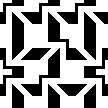 expanding the design through a diagonal choice
expanding the design through a diagonal choice 
![]() into a 72X36 repeat
into a 72X36 repeat ![]()
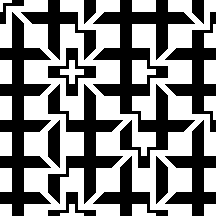 Large repeats require large swatches if gauge matters, but smaller tests serve well to evaluate tension and cam settings. It is a good idea to be consistent in yarn choice.
Large repeats require large swatches if gauge matters, but smaller tests serve well to evaluate tension and cam settings. It is a good idea to be consistent in yarn choice.
Thinking things through:
the white pixel areas will produce the pockets, separating from the ground, and the black pixel areas will compose the joined portions of knit.
To increase the effect, the height of those black pixel areas is reduced by changing their configuration in order to use the slip stitch setting to shorten them.
The first pattern fill requires doubling the height of the whole repeat in order to use the file in a tubular setting. ![]()
 Rather than doubling the file in height, this brush is used to fill the same black pixel areas.
Rather than doubling the file in height, this brush is used to fill the same black pixel areas. 
![]() After a few pixel cleanups, this is the final repeat,
After a few pixel cleanups, this is the final repeat, ![]()
 The png was tiled to the number of stitches planned, with the addition of a knit stitch border along each vertical side
The png was tiled to the number of stitches planned, with the addition of a knit stitch border along each vertical side ![]() and knit on 88 stitches for proof of concept.
and knit on 88 stitches for proof of concept.
End needle selection is on.
The carriages are set to slip in opposite directions, in either arrangement A or B.  In one-color knitting starting preselection side does not matter.
In one-color knitting starting preselection side does not matter.
The tension used, since so many stitches will be knitting on alternate beds, needs to approach that used for the same yarn when knitting stocking stitches.
The red yarn stitches mark the knit side of the fabric.
The cotton ball illustrates the formation of pockets.
The color change happened when the first cone of yarn ran out.
The yarns are 2/28 Italian imports of nonspecified fiber content.
The piece measures 10.5 inches in width.
When the settings are changed from tubular to every needle rib, the fabric is considerably wider and ruffles as seen at the top and bottom of the swatch, which could become a planned design feature.  A segment was cropped from the 72X36 drawn once more in repeat to 84X72, repeating the same steps for processing the file
A segment was cropped from the 72X36 drawn once more in repeat to 84X72, repeating the same steps for processing the file 

 alignment check
alignment check  If the plan is to evaluate the effect of tuck stitch on the design, to begin with, the file needs to be color reversed, whether in the drawn png or using machine settings
If the plan is to evaluate the effect of tuck stitch on the design, to begin with, the file needs to be color reversed, whether in the drawn png or using machine settings  Exploring results with the ribber set to knit in on every row, the swatch below the red line was produced with the knit carriage set to knit in one direction, tuck in the other, while in the remainder the knit carriage set to tuck in both directions. The areas that in slip stitch would form pockets knit in every needle rib, while tuck stitch segments produce a lacy effect.
Exploring results with the ribber set to knit in on every row, the swatch below the red line was produced with the knit carriage set to knit in one direction, tuck in the other, while in the remainder the knit carriage set to tuck in both directions. The areas that in slip stitch would form pockets knit in every needle rib, while tuck stitch segments produce a lacy effect.  The same design, using the png created prior to color reverse, set for tubular slip stitch
The same design, using the png created prior to color reverse, set for tubular slip stitch  the transition between the changes in knit carriage cam settings results in changes in textures and added width
the transition between the changes in knit carriage cam settings results in changes in textures and added width  The full tuck section (bottom) measures 16 inches in width, and the slip-stitch one (top) measures 11.5 inches.
The full tuck section (bottom) measures 16 inches in width, and the slip-stitch one (top) measures 11.5 inches.
Trying for a half-cardigan repeat with the same yarn produced an extremely wide knit with no discernible design.
Tired of double-bed knitting and swatches in a single color and large enough to cover pillows? the starting image reduced in size X4 to 21X18 pixels opens a new series of opportunities for knitting including on the single bed. 
![]() The design, knit here as DBJ, uses the built-in KRC color separation. At the bottom, the knit carriage is set to slip in both directions. The ribber uses the birdseye setting in both directions with the addition of lili buttons.
The design, knit here as DBJ, uses the built-in KRC color separation. At the bottom, the knit carriage is set to slip in both directions. The ribber uses the birdseye setting in both directions with the addition of lili buttons.
At the top, the knit carriage setting remains unchanged, and the ribber is set to knit in both directions, for a striper backing. The tension remained unchanged. The image illustrates the difference in the aspect ratio of the design and the height and width produced by the respective settings. 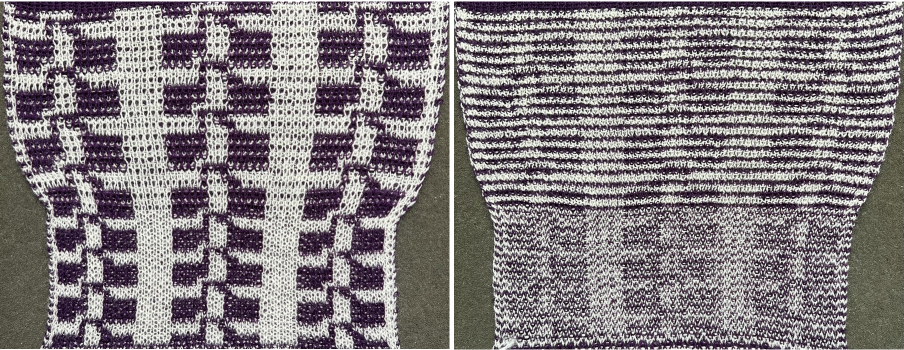 The same design knit as single bed fair isle produces problematic floats on the reverse which would need to be anchored down in a wearable.
The same design knit as single bed fair isle produces problematic floats on the reverse which would need to be anchored down in a wearable. 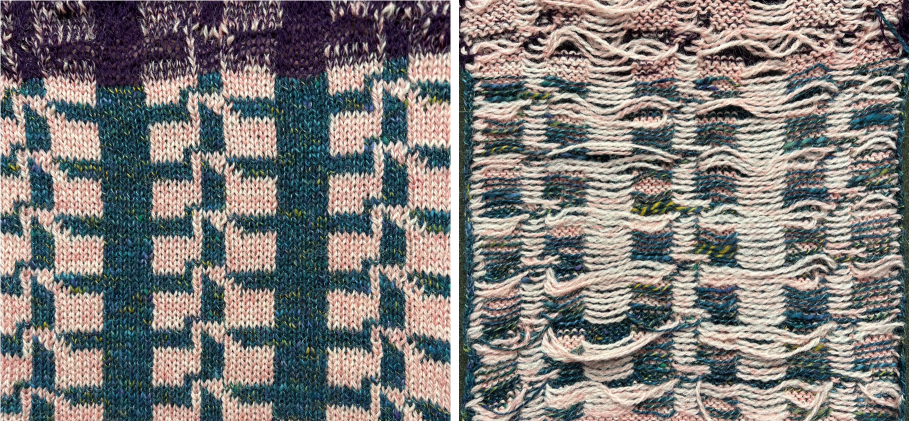 When knitting fair isle end needle selection is used to keep the yarn in the B feeder anchored so as to prevent any separations along the vertical edges of the design.
When knitting fair isle end needle selection is used to keep the yarn in the B feeder anchored so as to prevent any separations along the vertical edges of the design.
Here the light color is 2/8 wool. The yarn in the B feeder is switched to a 2/24 random contrasting color, and the knit carriage is set for thread lace. The white pixels knit both yarns together. Programming a blank row and knitting 2 yarns in this manner is considered by some an alternative to using the plaiting feeder.
End needle selection is canceled. If needles are brought forward, push at least one back to B so the combined yarns knit. In a long piece, a repeat in the width of the planned number of stitches could be planned with one or two blank pixel borders on vertical sides.
Due to the contrast in yarn thickness, the thin yarn creates large stitches that bulge in areas where it knits with the thicker yarn floating behind it, and the areas with combined yarns recede.
The areas in double thickness secure the yarn that produces floats, so that the latter may be trimmed on the purl side, leaving cut ends in any length. When cutting floats, consider sliding something under them and the thin knit so as to avoid cutting it as well, the fabric will release and flatten.  Using elastic, the background yarn used needs to be thinner, here a 2/20. The repeat program is left unchanged, but the position of the yarns is swapped so the elastic/ “thin” is placed in feeder A and the white/ “thick” in feeder B. There is a considerable change in size, observable at the top of the previous images.
Using elastic, the background yarn used needs to be thinner, here a 2/20. The repeat program is left unchanged, but the position of the yarns is swapped so the elastic/ “thin” is placed in feeder A and the white/ “thick” in feeder B. There is a considerable change in size, observable at the top of the previous images.  Aiming for float control, the repeat is edited.
Aiming for float control, the repeat is edited. 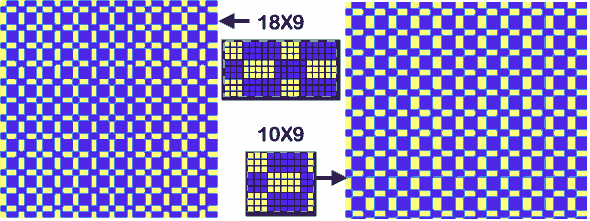 A test of the 18X9 repeat using the fair isle setting measures 6.5 inches in width,
A test of the 18X9 repeat using the fair isle setting measures 6.5 inches in width,  while the same stitch repeat knit using elastic and the thread lace setting adjustments once more, measures just under 2.5 inches in width
while the same stitch repeat knit using elastic and the thread lace setting adjustments once more, measures just under 2.5 inches in width 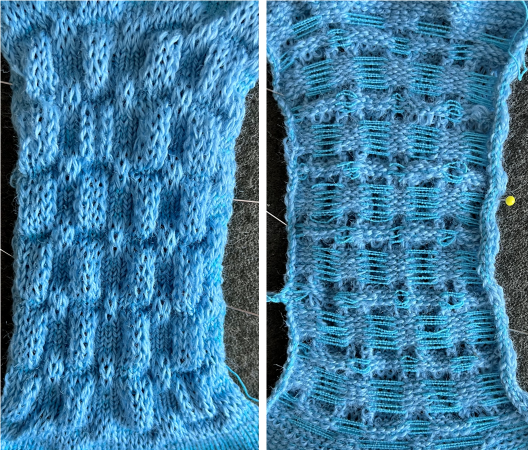
Category: Ribber Fabrics
Developing tiled repeats suitable for multiple stitch types, including tuck
Punchcard machine users have limitations in terms of repeat width, depending on the brand and age of the machine. Those numbers might vary from 8 to 12, 18, 30, and 40, with a 24-stitch width eventually becoming the most frequent.
When electronic machines were first released decades ago, multiple built-in functions allowed one to manipulate programmed repeats. The latter were drawn with electronic pencils (Studio) or far more often with permanent jet-black ink on mylar sheets or “cards”. Passap at one point developed the initial Wincrea version with a very short dongle for downloading designs to the console away from the knitting bed.
Brother was the first manufacturer to allow programming multiple repeats on a single mylar sheet. It took Studio some time to play catch up to eliminate all the potentially wasted space on them.
Both brands used mylars with 60 rectangular cells in width by 150 in height.
Variation buttons for the Brother 910: Building up a simple angular repeat can easily be done freehand filling in pixels, or with the use of the straight line tool in ArahPaint.
Building up a simple angular repeat can easily be done freehand filling in pixels, or with the use of the straight line tool in ArahPaint. ![]()
 The 12-stitch design may be mirrored and rotated in a variety of directions. For use in a punchcard, this may be done once in width, and three times in height to meet the minimum length requirement.
The 12-stitch design may be mirrored and rotated in a variety of directions. For use in a punchcard, this may be done once in width, and three times in height to meet the minimum length requirement.
It is not necessary when drawing to use only black and white to start with, though if the goal is ultimately to produce a programmable bmp or png, the final images need to be in those 2 colors.
It is easier to produce a design filling in fewer squares in lesser density and then to color reverse the results if that is required for the specific stitch type.
A: using horizontal and vertical mirroring yields the start of a diamond shape. Punchcard users may find it easier to mark the dark squares and punch everything else if the goal is to use the tuck stitch setting or to have a card “safe for everything”
B: checking alignment by tiling the file
C: if the intended goal is tuck stitch, and the minimum information is drawn in the design, then the repeat must be color reversed, whether in the program used to create the file or by selecting the built-in function in an electronic after download.
D: the color reverse image tiled, may be suitable for some interesting fair isle striping or exchanges of positive/negative spaces at the intersection of any of those rows where the double-height or double-width markings occur.
Red cells indicate two side-by-side unpunched holes or unmarked pixels. In theory, this breaks the tuck rule requiring a knit stitch/ unpunched hole or black pixel on either side of an unpunched area/white pixel, but it likely will be fine, producing something that looks more like a slipped stitch than a tuck.
The double-height areas marked in green would be a problem if one were to test the repeat by doubling its length, with a compounded issue in those areas where tuck stitches would then happen on side-by-side needles for 4 consecutive rows.
Usable with some care for knit weaving, slip stitch, and other stitch types. Results are not discovered unless actually tested.
Keep good notes.  Breaking the design into segments to knit as a striped fair isle ie in these 4 places
Breaking the design into segments to knit as a striped fair isle ie in these 4 places  Variations are easier to imagine if one begins with colored repeat segments that can, in addition, be varied using color exchanges to resemble approximate yarn colors. Instructions on color banding using ArahPaint follow at post bottom.
Variations are easier to imagine if one begins with colored repeat segments that can, in addition, be varied using color exchanges to resemble approximate yarn colors. Instructions on color banding using ArahPaint follow at post bottom.  In the last post, the same image was mirrored using ArahPaint
In the last post, the same image was mirrored using ArahPaint  The result is a 23X23 pixel design.
The result is a 23X23 pixel design.
Any incrementally larger repeats would require the same operations, using the mirror X-1 and Y-1 options to avoid any side-by-side equal cells, but the process is easier with some understanding of isolating repeats. When the 23-stitch file has been formed, manually trim one pixel along the bottom or top row, and one along either the left or right side, down to 22X22 pixels ![]() tested in B/W repeat
tested in B/W repeat 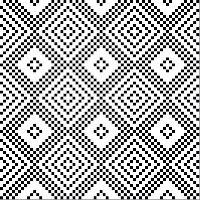 and here color inverted
and here color inverted 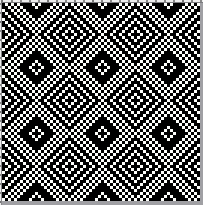 it is executable in double length
it is executable in double length ![]() thus offering the opportunity for color changing every 2 rows, testing the possibility of its morphing into a mosaic/maze design, remembering first to color reverse the repeat as given here,
thus offering the opportunity for color changing every 2 rows, testing the possibility of its morphing into a mosaic/maze design, remembering first to color reverse the repeat as given here, ![]() which in turn yields a file that may be knit with color changes every 2 rows, a technique that can produce maze/mosaic designs with an appearance very different from the same pattern knit as fair isle.
which in turn yields a file that may be knit with color changes every 2 rows, a technique that can produce maze/mosaic designs with an appearance very different from the same pattern knit as fair isle.
In this swatch, 2/20 wool yarns were used. This results in a knit that can be steamed to stay flat.
The variations in the amount of tucked stitches and their placement expand in some areas more than others yielding wavy vertical side edges.
The striping occurred to enhance the visibility of stitch formations on the machine, but can be a deliberate way to add even more colors to such pieces. 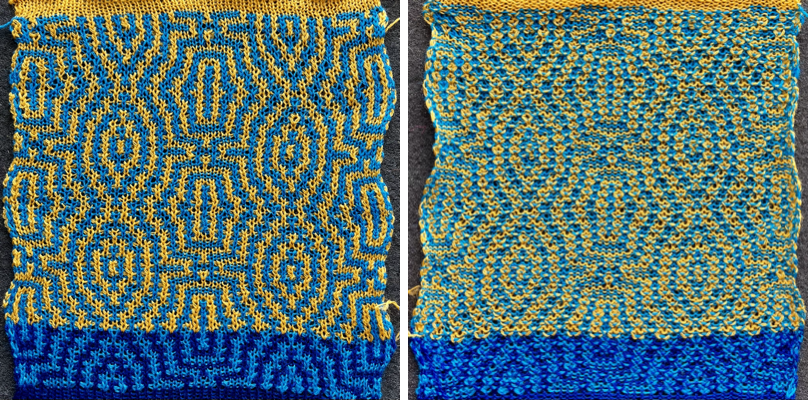 The same design, knit in 2/8 wool, begins to show that a pattern may produce very different effects with a simple change in materials or color choice
The same design, knit in 2/8 wool, begins to show that a pattern may produce very different effects with a simple change in materials or color choice 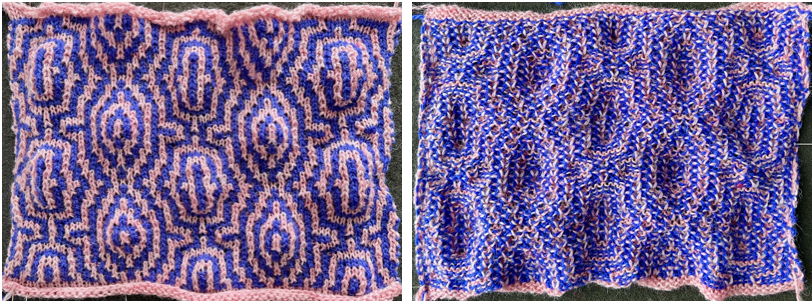 Working outside straight lines and exploring random starts: the post Working with diagonal patterning in machine knitting introduced several larger initial repeats also suitable for tuck patterning when reversed, including this 12X24 pixel design,
Working outside straight lines and exploring random starts: the post Working with diagonal patterning in machine knitting introduced several larger initial repeats also suitable for tuck patterning when reversed, including this 12X24 pixel design, ![]() and the companion larger file, 144X144 pixels
and the companion larger file, 144X144 pixels 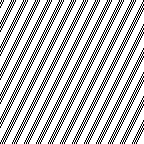 The larger file can serve as the start for exploring knit pattern variations through the use of filters.
The larger file can serve as the start for exploring knit pattern variations through the use of filters.
A description of filters and their use may be found on pp 88-101 of the user manual (thumbnails # 96-108).
A “fast pattern” user guide shared by the ArahPaint 6 developer October 2023 which demonstrates how to use filters with associated designs https://www.arahne.eu/pdf/fastpattern-EN.pdf
The associated tool options:  This first series uses only the Contour filter
This first series uses only the Contour filter ![]() and random selection of arrows from this tool
and random selection of arrows from this tool
beginning with a 12X12 pixel design ![]() developing it into a 31X31 one, not all doubled pixels eliminated doubled pixels eliminated
developing it into a 31X31 one, not all doubled pixels eliminated doubled pixels eliminated ![]()

![]()

![]()
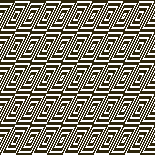
![]()
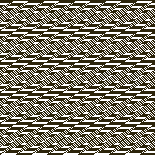
![]()
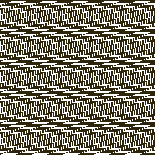 The Zigzag filter creates a zigzag from the image. The number of zigzags depends on the setting of the filter option’s X, Y, and Values and the direction, Horizontal or Vertical, or a combination of both.
The Zigzag filter creates a zigzag from the image. The number of zigzags depends on the setting of the filter option’s X, Y, and Values and the direction, Horizontal or Vertical, or a combination of both.
X: determines the number of zigzags up and down, the number should be an even number ie. 144 divided by 12 would create 12 peaks
Y: creates the vertical direction of peaks
Value: set to 0 the whole image height is taken as amplitude
The variations can be endless, and exploring changes in settings will help develop a sense of what happens. The larger scale results may at times be reduced to a significantly smaller working repeat. Tools/Find Repeat often but not always will do that seamlessly.
The manual offers instructions for manipulating vertical bands of color. Such variants could be knit as intarsia or multiple colors per row, with limitations and considerations.
This 4X4, vertical repeat, tiled to 12X12 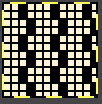 color reversed for tuck knitting
color reversed for tuck knitting ![]() drawn in repeat and filtered is knittable, but not interesting to me. The result, shown tiled for clarity
drawn in repeat and filtered is knittable, but not interesting to me. The result, shown tiled for clarity 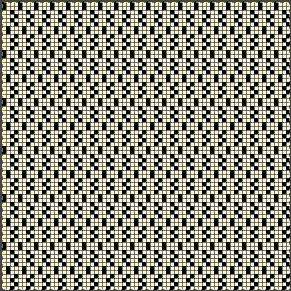 Moving away from straight lines, these initial experiments employed limited variations. The red X mark marks the repeat suitable only for fair isle knitting
Moving away from straight lines, these initial experiments employed limited variations. The red X mark marks the repeat suitable only for fair isle knitting 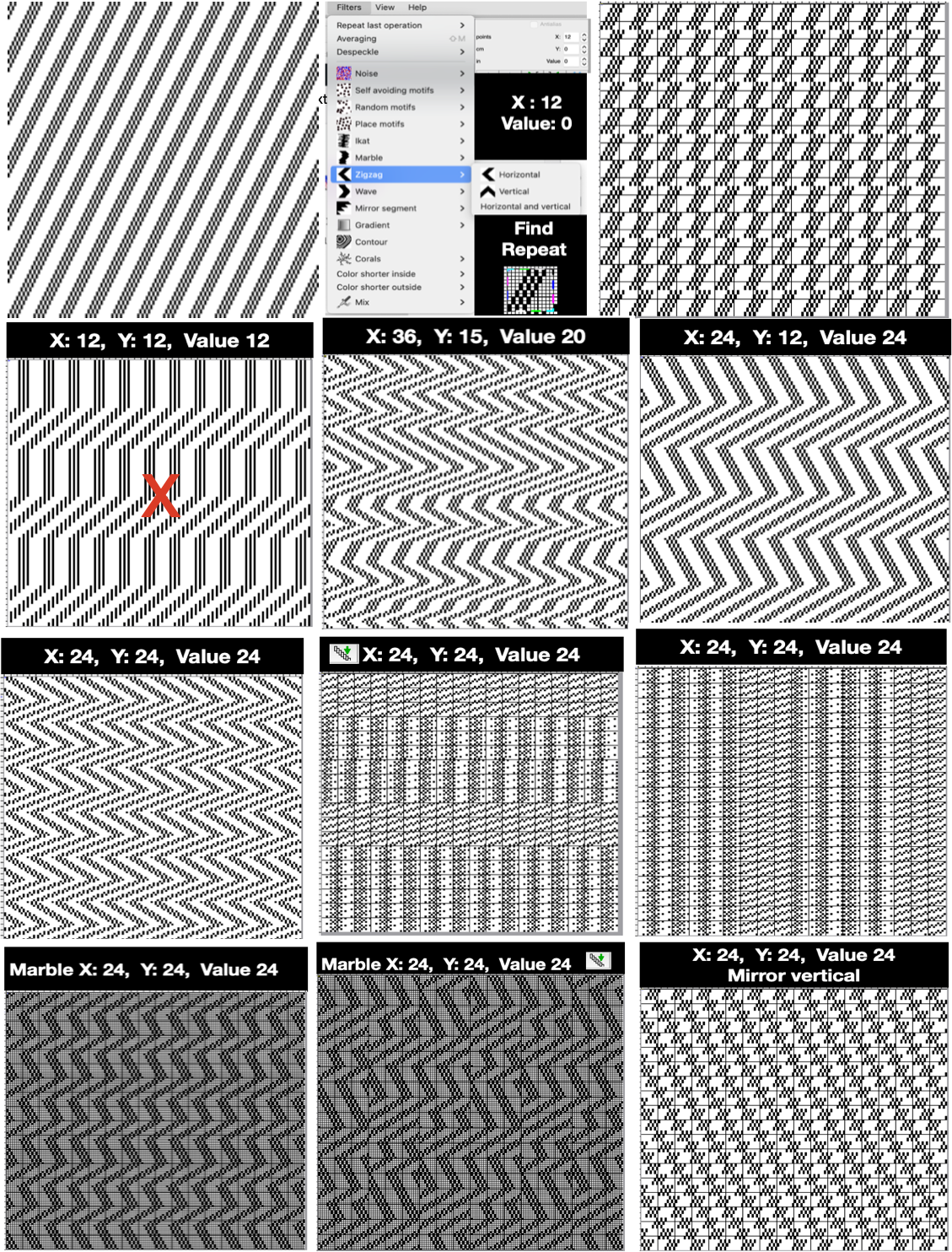 Choosing individual results to knit in tuck stitch, in review: the smallest repeats may be isolated and pixels cleaned up if preferred, remembering to color reverse when needed. This 24X24 repeat is suitable for punchcard models with the black pixels areas punched. Testing is far easier and quicker using electronic machines, do not use double length
Choosing individual results to knit in tuck stitch, in review: the smallest repeats may be isolated and pixels cleaned up if preferred, remembering to color reverse when needed. This 24X24 repeat is suitable for punchcard models with the black pixels areas punched. Testing is far easier and quicker using electronic machines, do not use double length ![]()
 The design is asymmetric, subject to personal preference, and as usual, with results dependent on yarn and color choice.
The design is asymmetric, subject to personal preference, and as usual, with results dependent on yarn and color choice.
The yarn used at the top of the photo is a wool-rayon, knit single bed. It was hard to identify stitch formations, hence the swatch was short in height for a visual texture check. Because of the rayon content, all edges steam and press fairly flat.
The other yarn is all wool, knit in every needle rib with the knit carriage set to tuck in both directions, and the ribber carriage set to knit in both.
This type of knit is often referred to as pick rib. Depending on the tuck stitch distribution, the stitches are forced apart vertically and can produce an eyelet effect in a fabric that lies quite flat. 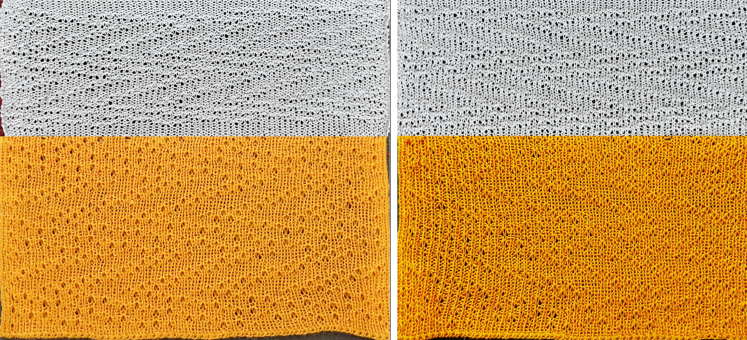 A closer look at approximately the same part of the ribbed fabric.
A closer look at approximately the same part of the ribbed fabric.  A 58X16 file after some cleanup and cropping of one of the other variations is to be color-reversed for use with the tuck setting. Depending on the thickness of the yarn, double length may be used safely for added texture.
A 58X16 file after some cleanup and cropping of one of the other variations is to be color-reversed for use with the tuck setting. Depending on the thickness of the yarn, double length may be used safely for added texture. ![]()
![]() The swatch illustrates the difference between fair isle knitting and tuck stitch, even when the tension used in the knit carriage remains fixed. Fair isle is in the slip stitch family, so it is short and narrow, while tuck stitch tends to be short and wide. It is usually recommended that fair isle floats be no wider than 5 pixels. Many here break that rule and would need to be managed if the design were to be used in a finished garment.
The swatch illustrates the difference between fair isle knitting and tuck stitch, even when the tension used in the knit carriage remains fixed. Fair isle is in the slip stitch family, so it is short and narrow, while tuck stitch tends to be short and wide. It is usually recommended that fair isle floats be no wider than 5 pixels. Many here break that rule and would need to be managed if the design were to be used in a finished garment.  This
This 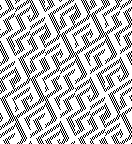 segmented
segmented  and cropped to 17X144 pixels
and cropped to 17X144 pixels![]() Mirrored X-1, 33X144 pixels
Mirrored X-1, 33X144 pixels ![]() I like to plan repeats for any intended piece when possible in a width matching the number of needles in use, which allows programming as single-motif in the 930 with img2track and eliminates the need to turn on other built-in functions or assign needle positions. Doing so also offers the opportunity to add borders if desired.
I like to plan repeats for any intended piece when possible in a width matching the number of needles in use, which allows programming as single-motif in the 930 with img2track and eliminates the need to turn on other built-in functions or assign needle positions. Doing so also offers the opportunity to add borders if desired.
A 99X144 version  was programmed, and the central 71 stitch width was tested, likely suitable for an accessory ie a scarf
was programmed, and the central 71 stitch width was tested, likely suitable for an accessory ie a scarf  Those side-by-side white pixels are “OK” since they are in turn sided by black pixels and do not repeat for more than 2 rows.
Those side-by-side white pixels are “OK” since they are in turn sided by black pixels and do not repeat for more than 2 rows.
At some point, one needs to commit to actual knitting. The first proof of concept swatch was knit in a softly spun, shiny rayon that had a slight tendency to split during knitting and steams and sets nearly completely flat. 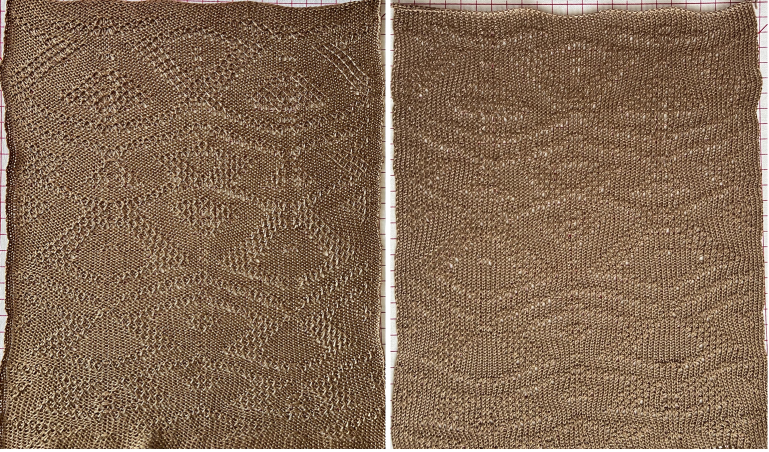 This swatch is knit using a 2/8 wool, retains its texture after steaming and pressing, and exhibits the usual roll to the knit side at the top and bottom of the piece, and to the purl side along the vertical side edges. The variations in the 3D surface that can happen with some tuck patterns appear here and are retained.
This swatch is knit using a 2/8 wool, retains its texture after steaming and pressing, and exhibits the usual roll to the knit side at the top and bottom of the piece, and to the purl side along the vertical side edges. The variations in the 3D surface that can happen with some tuck patterns appear here and are retained.  A brief look at Gradient filter included in post on Truchet inspired tiles.
A brief look at Gradient filter included in post on Truchet inspired tiles.
Restricted use images may also be built from scratch.
Large published illusion-style designs even if beginning as black and white when scaled down in size can lose definition as a result rendering them speckled, needing a lot of pixel cleanup, or completely unusable.
This first attempted DIY version begins with a 31X31 repeat. The odd number allows for a corner-to-corner start. The lines are drawn using the straight line tool, with pencil size alternating between one and 2 pixels 
![]() Using mirror X-1, Y -1 to 61X61
Using mirror X-1, Y -1 to 61X61  trimming by a single pixel and width and height for routine tiling avoids lots of doubled pixels. The final repeat, with small single pixels placement edits, is now 60X60
trimming by a single pixel and width and height for routine tiling avoids lots of doubled pixels. The final repeat, with small single pixels placement edits, is now 60X60  repeated in height only it could be used for perhaps a scarf, with or without solid borders at the bottom, top, and sides.
repeated in height only it could be used for perhaps a scarf, with or without solid borders at the bottom, top, and sides.  Drawn in repeat X3 in both X and Y directions it produces a 180X180 file large enough for a blanket, with a bit of wiggle room to add a narrow solid color frame if desired.
Drawn in repeat X3 in both X and Y directions it produces a 180X180 file large enough for a blanket, with a bit of wiggle room to add a narrow solid color frame if desired. 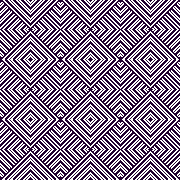 The design may be knit as fair isle for a quick initial test or for a final piece since the floats are all very short or knit as DBJ to produce a no-roll final fabric without floats.
The design may be knit as fair isle for a quick initial test or for a final piece since the floats are all very short or knit as DBJ to produce a no-roll final fabric without floats.
In this test, softly spun rayon and heathery wool were used, resulting in a surprising color mix when compared to their original colors. There were a few spots where the rayon fiber split and knit with the contrast. The end needle selection was off, so there are tiny eyelets in some places where the contrast was not knit on the side edge, and the fabric separates a bit. 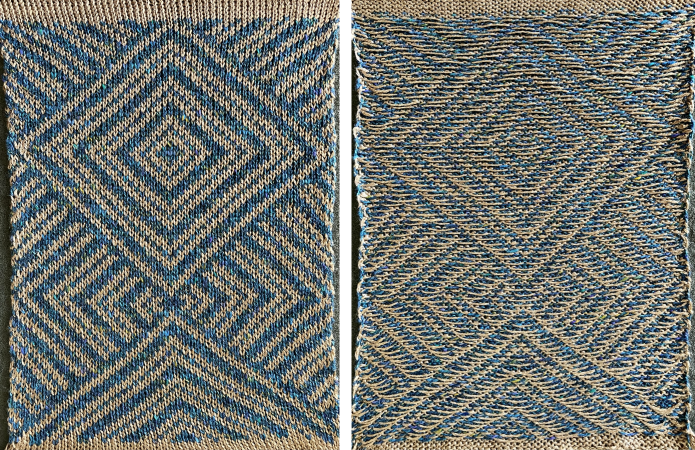 A variation for a different vertical repeat can easily be isolated from tiled drawings. This additional sample was also knit as a fair isle, with end needle selection on.
A variation for a different vertical repeat can easily be isolated from tiled drawings. This additional sample was also knit as a fair isle, with end needle selection on. 


 An added instance of selecting changing the focus from an original tiled 46X46 repeat
An added instance of selecting changing the focus from an original tiled 46X46 repeat![]()
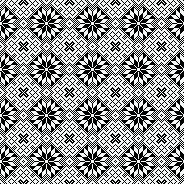
![]()
 Suitable for punchcard knitting: a 12-stitch simple geometric repeat
Suitable for punchcard knitting: a 12-stitch simple geometric repeat![]()
 visualized X12
visualized X12  modified using drawing X12 in random repeat for electronic machines.
modified using drawing X12 in random repeat for electronic machines. 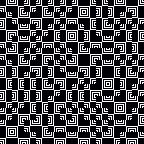 16X38
16X38![]()
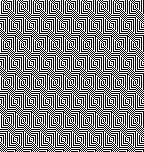 20X16
20X16 ![]()
 29X29
29X29 ![]()
 30X30
30X30 ![]()
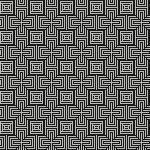 42×46
42×46 ![]()
 When the planned illusion is simple line distortion
When the planned illusion is simple line distortion
18X18 “Café Wall” distortion ![]()
 tested on a 60 stitch width, the bottom is double-stranded birdseye DBJ with a shift to single strands at the top. The single plies produce a wider, softer knit
tested on a 60 stitch width, the bottom is double-stranded birdseye DBJ with a shift to single strands at the top. The single plies produce a wider, softer knit 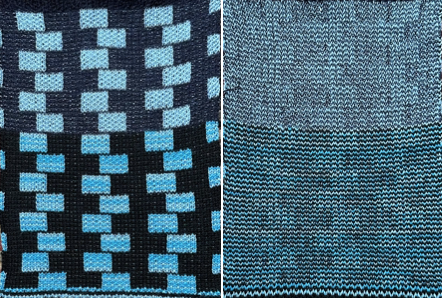 imagining a wider piece
imagining a wider piece 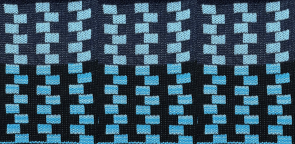 10X10 repeat
10X10 repeat 
![]()
 Knit as DBJ, in 2/20 wool single strand, at as tight a tension as possible to allow for proper stitch formation, the bleed-through is quite visible, the swatch is also 60 stitches wide
Knit as DBJ, in 2/20 wool single strand, at as tight a tension as possible to allow for proper stitch formation, the bleed-through is quite visible, the swatch is also 60 stitches wide 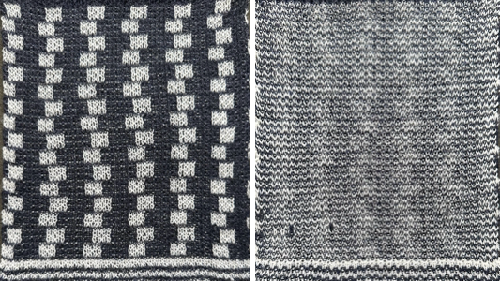 There is a discussion online whether adding a single row of a contrasting color heightens the illusion, a 9X10 repeat adding a third color
There is a discussion online whether adding a single row of a contrasting color heightens the illusion, a 9X10 repeat adding a third color ![]()
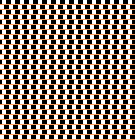 Larger, 30X30 design with lots of dots creating short floats, suitable for FI single bed
Larger, 30X30 design with lots of dots creating short floats, suitable for FI single bed 
![]()
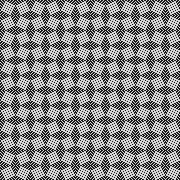 with no dots, more suitable for DBJ
with no dots, more suitable for DBJ 
![]()
 Shifting gears, a different 18X18
Shifting gears, a different 18X18 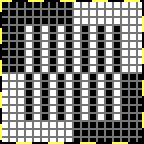
![]() visualized X 9
visualized X 9  modified using random
modified using random 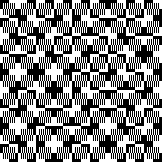 nearly the width of the full needle bed, 172X169
nearly the width of the full needle bed, 172X169  A 24-stitch repeat
A 24-stitch repeat 
![]()
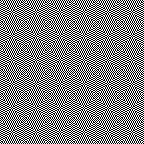
 accomplishes an optical illusion of sorts. If only it would work for creating origami-style pleats!
accomplishes an optical illusion of sorts. If only it would work for creating origami-style pleats!
A former Ravelry query prompted these designs working with blocks
a 16X16 file ![]() color reversed
color reversed ![]() combined for a 32X32 final repeat
combined for a 32X32 final repeat 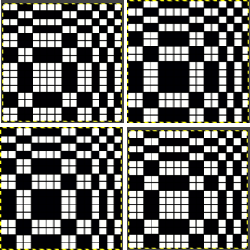
![]() drawn in repeat
drawn in repeat 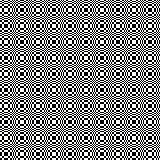 20X20
20X20
![]()
 22×22
22×22![]()
 22X30
22X30![]()
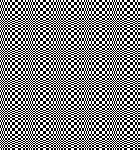 66X60
66X60


44X54![]()
 42X46
42X46
![]()
 from a weaving draft, 46X46
from a weaving draft, 46X46 ![]()
 63X63
63X63 
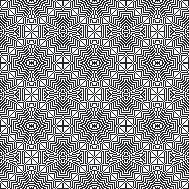 adding a third color is easy in the larger blocks, the standard 3 color automatic separations are likely to lengthen the design
adding a third color is easy in the larger blocks, the standard 3 color automatic separations are likely to lengthen the design 
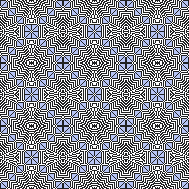 BW trimmed to 62X62 to eliminate double stitches
BW trimmed to 62X62 to eliminate double stitches 
 66X66
66X66 
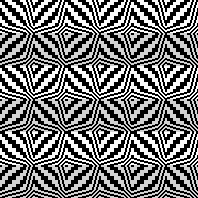 Johann Karl Friedrich Zöllner (1834 – 1882), a German astrophysicist with a keen interest in optical illusions was inspired by a cloth pattern that he observed in his father’s factory and first published the illusion that bears his name in the journal Annalen der Physik in 1860. The acute angles formed by the intersections of the short and long lines make the spaces between the diagonals appear to expand.
Johann Karl Friedrich Zöllner (1834 – 1882), a German astrophysicist with a keen interest in optical illusions was inspired by a cloth pattern that he observed in his father’s factory and first published the illusion that bears his name in the journal Annalen der Physik in 1860. The acute angles formed by the intersections of the short and long lines make the spaces between the diagonals appear to expand.
My knittable adaptation: the 84X84 repeat 
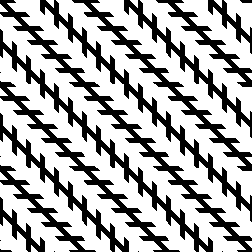 Building tiny shapes into secondary ones inspired by weaving drafts
Building tiny shapes into secondary ones inspired by weaving drafts
56X148 
 110X225
110X225 
 Removing doubled vertical segments, 106X225
Removing doubled vertical segments, 106X225 
 Adding colors to black and white pngs following the tip by the developer in the post comments:
Adding colors to black and white pngs following the tip by the developer in the post comments:
Choose a black-and-white repeat, in this case, a 36X9 pixel repeat ![]() Double-click on one of the two colors to protect/lock it
Double-click on one of the two colors to protect/lock it  Double-click on it again, and the lock disappears, the color is no longer protected.
Double-click on it again, and the lock disappears, the color is no longer protected.
In the palette, use + to add a new color, this may be repeated more than once to add more colors or go to colors, set the number of colors to a number, ie. 6, for a random palette group that may, in turn, be edited to other values.  Double-click on the rectangle tool to draw filled rectangles
Double-click on the rectangle tool to draw filled rectangles  In rectangle options, above the palette icon, there are toggle buttons for Horizontal and Vertical, remember to protect a color
In rectangle options, above the palette icon, there are toggle buttons for Horizontal and Vertical, remember to protect a color 
 Once your selection is made, draw the filled rectangle across a selected width and height while keeping the protected color intact. Draw the result in repeat to check for alignment
Once your selection is made, draw the filled rectangle across a selected width and height while keeping the protected color intact. Draw the result in repeat to check for alignment  the protected color may be toggled to white
the protected color may be toggled to white  If the designs are to be programmed for multiple color slip stitch or DBJ there are rules to be observed, and there may be restrictions on whether each palette color will be recognized as a third or fourth color by the download program ie. when using Ayab, where no two colors may occur in the same range of 8-bit values. For 4 colors, the ranges would be 0-63, 64-127, 128-195, and 196-255.
If the designs are to be programmed for multiple color slip stitch or DBJ there are rules to be observed, and there may be restrictions on whether each palette color will be recognized as a third or fourth color by the download program ie. when using Ayab, where no two colors may occur in the same range of 8-bit values. For 4 colors, the ranges would be 0-63, 64-127, 128-195, and 196-255.
The img2track partial window with the associated color assignments for the first vertical variation. 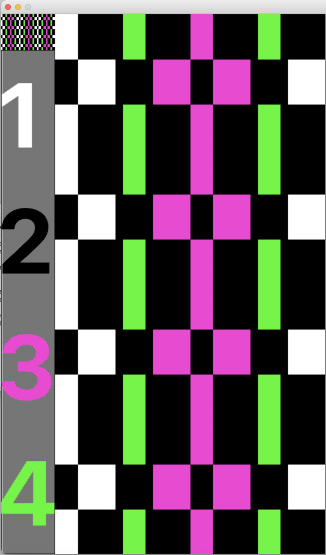 The horizontal choice allows one to play with selections possibly matching yarn colors in fair isle knitting,
The horizontal choice allows one to play with selections possibly matching yarn colors in fair isle knitting,  only 2 colors per row may be used, here the A feeder yarn remains fixed
only 2 colors per row may be used, here the A feeder yarn remains fixed  Remember to unlock the previous color choice if protecting new segment selections.
Remember to unlock the previous color choice if protecting new segment selections.
Visualizing possible FI striping results in progress 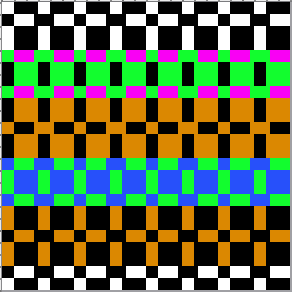
More Truchet inspired tiles, a brief look at gradient filter use
The latest ArahPaint user manual download, updated on February 9, 2023, includes added directions for drawing in repeat including a truchet/Smith tile variant.
This post will not provide specific how-tos, the pngs can be downloaded and used to perhaps test Arah’s features or to aid in finding a personal, preferred method for manipulating DIY designs.
There are additional Arahpaint options for altering designs in width and height which may be used progressively on the same image. Some in the group of edits and rotations are evocative of the Passap console’s Alter programming loop. 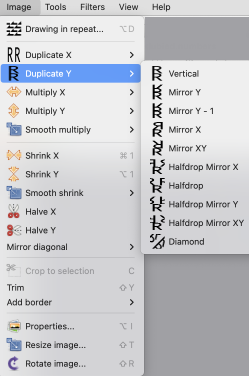 Lower in the same menu, diagonal mirroring opens yet another series of possibilities.
Lower in the same menu, diagonal mirroring opens yet another series of possibilities. 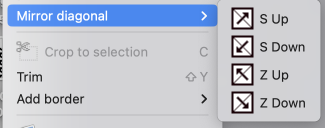 These samples were produced in a Passap workshop, using the console Alter, add commands. Note that mirrored areas have identical pairs of side-by-side pixels at their meeting points,
These samples were produced in a Passap workshop, using the console Alter, add commands. Note that mirrored areas have identical pairs of side-by-side pixels at their meeting points, 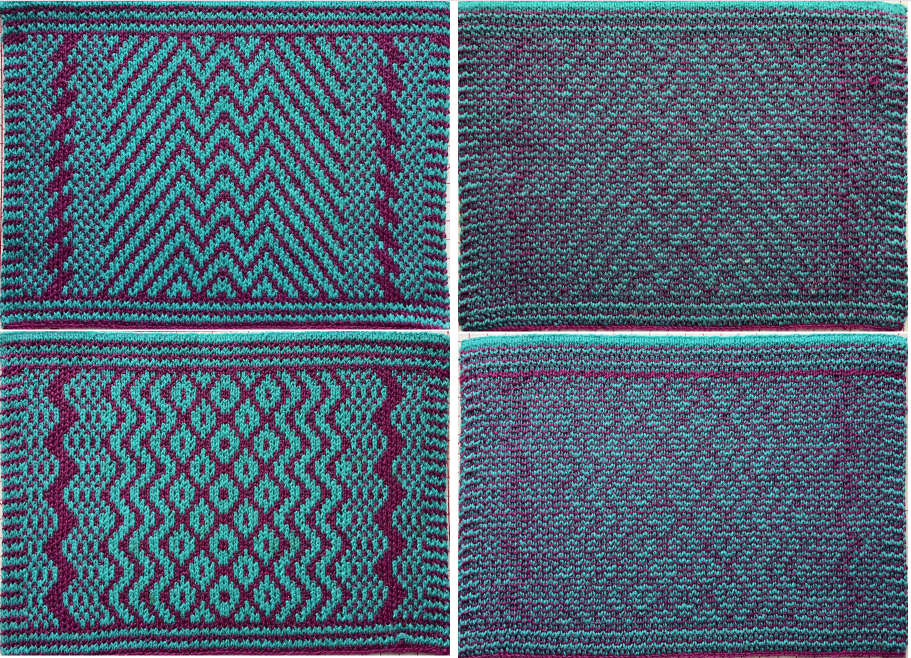 while ArahPaint offers an opportunity to change that, a thing to keep in mind when returning to simpler motifs such as those used for tuck stitch. Performing the rotations, however, will render the result with an odd number of pixels in width, often making them less likely to be usable in punchcard models
while ArahPaint offers an opportunity to change that, a thing to keep in mind when returning to simpler motifs such as those used for tuck stitch. Performing the rotations, however, will render the result with an odd number of pixels in width, often making them less likely to be usable in punchcard models  My area of interest has been primarily and still is in creating textures beginning with small repeats that may grow in complexity and size to make the structures programmable and thus easier to track and execute.
My area of interest has been primarily and still is in creating textures beginning with small repeats that may grow in complexity and size to make the structures programmable and thus easier to track and execute.
Presently I rarely engage in multiple color motif work ie fair isle or other large-scale textile pattern applications but my curiosity in applied techniques has led me down this potential giant rabbit hole.
The speed and ease of drawing variations for repeats using ArahPaint make the process addictive.
The source of inspiration for this design series is “The curse of truchet tiles”.
When recognizable circles are a goal, these tiled motifs often begin with starting sizes as wide as the 24-stitch standard punchcard repeat limitation, and the manipulated larger motifs are suitable only for electronic machine models capable of accepting software downloads. ![]()
![]()
![]()
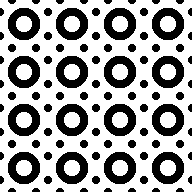 Adding lines and extra dots of circles
Adding lines and extra dots of circles
![]()

 Isolating fractions and individually rotating segments to draw again rendering larger repeats
Isolating fractions and individually rotating segments to draw again rendering larger repeats ![]()
![]()
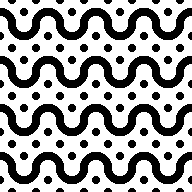
![]()
 More info on knitting DBJ using more than 2 colors per row:
More info on knitting DBJ using more than 2 colors per row:
DBJ: more than 2 colors per row 3 3/22
Img2track_multiple colors per row dbj, each color knitting only once 1/21
DBJ: more than 2 colors per row 2 12/19
DBJ: more than 2 colors per row 1 12/19
Adding one more color to the last repeat whole planning a knitting a test at a max of 3 colors per row knittable in a single track
![]()
![]() The img2track window
The img2track window  Positions of the respective yarns in the color changer as suggested by the program result in accuracy prompts by the machine on which of the respective colors should be in use at any one time.
Positions of the respective yarns in the color changer as suggested by the program result in accuracy prompts by the machine on which of the respective colors should be in use at any one time.  Planning gauge-dependent pieces using large repeats requires large test swatches, generally a minimum of 100 stitches by 100 rows.
Planning gauge-dependent pieces using large repeats requires large test swatches, generally a minimum of 100 stitches by 100 rows.
Adding and varying the colors in the design draft to match the yarns to be used in the repeat helps to visualize the possible result, and allows for using the sequence suggested by the download program to help track the proper color changes.
The test here is 60 stitches wide, knit one full repeat in height, measuring 7.5 inches in width by 11.75 inches in height after resting. On rows where the colors for the dots and squiggles may knit in small parts or not at all, there will be a preselection of large groups of needles such as seen here. 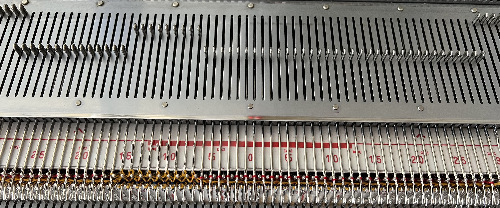 Birdseye setting is used to decrease motif lengthening. The img2track user manual describes the steps necessary for downloading to different model knitting machines and possibly using more than single tracks.
Birdseye setting is used to decrease motif lengthening. The img2track user manual describes the steps necessary for downloading to different model knitting machines and possibly using more than single tracks.  A series inspired by another of the tiles in the linked publication
A series inspired by another of the tiles in the linked publication


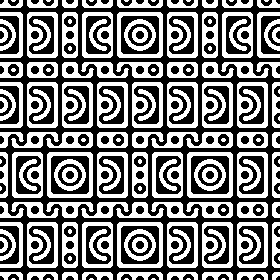
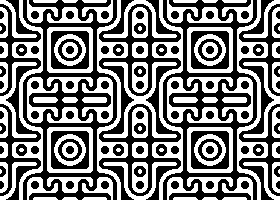 Similar to one of the source repeats, increasing the balance between light and dark
Similar to one of the source repeats, increasing the balance between light and dark 
 Open areas or specific rotations in the visual space may be created by eliminating or rotating individual segments.
Open areas or specific rotations in the visual space may be created by eliminating or rotating individual segments.
To change the mirroring type, place a mouse pointer over the arrow that you want to change, and press the left mouse button. The arrow will jump to the next mirror type. With only 5 mirror types, you will get what you want in a maximum of 4 clicks. If you press the right mouse button, it will put the arrow to the default orientation. 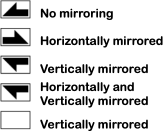 The result of course is dependent on the original file choice.
The result of course is dependent on the original file choice. 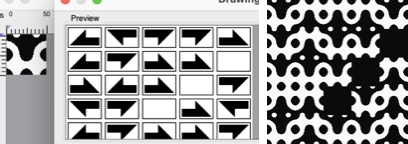 Combining duplicating repeat variations with drawing in repeat helps one develop a DIY library of favored tilings. Begin with a possible background
Combining duplicating repeat variations with drawing in repeat helps one develop a DIY library of favored tilings. Begin with a possible background 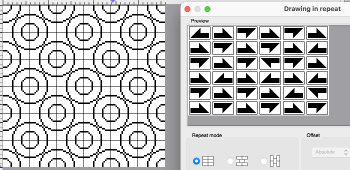
 Tools/ Find Repeat
Tools/ Find Repeat ![]() Aiming for knot variations, a cross-over to add to segments of the ground, manipulating individual tiles, adding copy and paste
Aiming for knot variations, a cross-over to add to segments of the ground, manipulating individual tiles, adding copy and paste ![]()
![]()
![]()




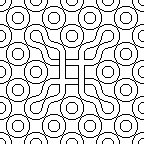 More play with manual duplication of tiles as opposed to drawing in repeat
More play with manual duplication of tiles as opposed to drawing in repeat  Combining different scale repeat segments, starting with 54X36 pixels
Combining different scale repeat segments, starting with 54X36 pixels ![]()

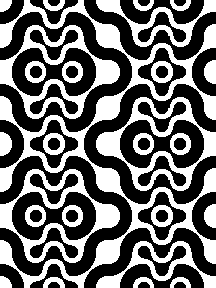 And it’s not all about just circles, a 36X36 pixel design to play with
And it’s not all about just circles, a 36X36 pixel design to play with ![]()
 A reminder, if the plan is to add color in continuous lines, it is best to place the colors after the full design repeat has been developed rather than on the individual starting tile segments, For some, this would be considered a design feature.
A reminder, if the plan is to add color in continuous lines, it is best to place the colors after the full design repeat has been developed rather than on the individual starting tile segments, For some, this would be considered a design feature.  A very different look may be achieved using any of the available filters. A square image of any size may be filled with a color gradient while keeping in mind the fact that knitting is very low resolution and the maximum number of available needles for patterning is 200 or under.
A very different look may be achieved using any of the available filters. A square image of any size may be filled with a color gradient while keeping in mind the fact that knitting is very low resolution and the maximum number of available needles for patterning is 200 or under.
Beginning with a 20-stitch file. ![]() Below the software tool options on the right, click on the tool in the area marked with the red shape
Below the software tool options on the right, click on the tool in the area marked with the red shape  to produce a design that may then in turn be drawn in repeat
to produce a design that may then in turn be drawn in repeat ![]()
![]() No edges were cleaned up in this view. The design meets the maximum 200 pixels/needles size
No edges were cleaned up in this view. The design meets the maximum 200 pixels/needles size 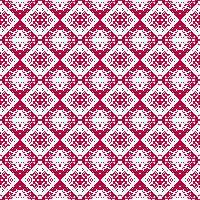 Going larger, an 80-pixel start to end with a 160-pixel blanket or tapestry suitable image with some wiggle room for adding a frame/border.
Going larger, an 80-pixel start to end with a 160-pixel blanket or tapestry suitable image with some wiggle room for adding a frame/border. 

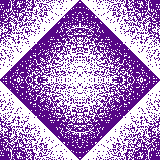
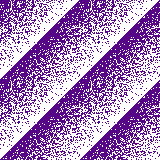
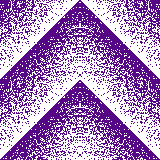 The concept may be used in various densities for use in an accessory such as a scarf,
The concept may be used in various densities for use in an accessory such as a scarf, 
 spaced and colored to your liking,
spaced and colored to your liking, 
 or even sweater bodies and sleeves planned specifically based on stitch and row counts for each of the pieces involved.
or even sweater bodies and sleeves planned specifically based on stitch and row counts for each of the pieces involved. 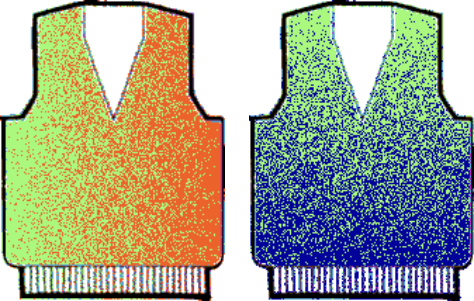 Filters may also be applied in developing other stitch structures in addition to working with color motif designs. That topic merits its own post.
Filters may also be applied in developing other stitch structures in addition to working with color motif designs. That topic merits its own post.
A “fast pattern” user guide shared by the ArahPaint 6 developer October 2023 which demonstrates how to use filters with associated designs https://www.arahne.eu/pdf/fastpattern-EN.pdf
Truchet/Smith inspired designs 2 meet ArahPaint
Added explorations of the Smith tiles.
Most common knitting machines capable of accepting electronic pattern downloads have a number of needles ranging between 180 and 200 on either of the available beds.
Punchcard machines have a 24-stitch constraint in width for repeats that are selected in fixed locations on the top bed, while height row counts can be endless if one keeps joining punchcards together.
The narrow repeat width does not allow for impactful tiling such as seen in the truchet variants.
A 24-stitch initial repeat can be created, but will not align properly ie. here:
the 24X56 png, ![]() colored in and repeated in width and height X3.
colored in and repeated in width and height X3. 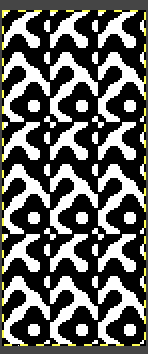 It can, however, be drawn in repeat using ArahPaint to produce a new and successful design repeat ie this 48X112 pixels version
It can, however, be drawn in repeat using ArahPaint to produce a new and successful design repeat ie this 48X112 pixels version ![]() and its appearance in repeat on a larger canvas:
and its appearance in repeat on a larger canvas:  Electronic machines can be used to knit large, non-repetitive designs based on the number of needles available on their beds.
Electronic machines can be used to knit large, non-repetitive designs based on the number of needles available on their beds.
Unless knit-from-screen software is used, the size of the files downloaded to specific machine models varies depending on both the software used and the knitting machine’s available memory.
One of the issues using online generators as seen in the previous post is that the files tend to be high in pixel counts and rendered in RGB mode.
Changing image modes to BW indexed and scaling the large design to a smaller version have an effect on the edge definition of the shapes and are likely to require clean-up to remove or add pixels.
Beginning with small and clearly defined forms, tiling repeatedly to larger ones will allow for results that can be cropped to specific sizes with clean edges along the secondary shapes.
Beginning the proposed method with the Smith tile, a place to start is to choose the smallest successful circular forms.
The repeat works using quarter squares, so the file size needs to be an even number of pixels in width and height.
Getting a sense of the appearance of the edges of small circular shapes, with the intent of choosing one for fabric development, beginning with an 8-pixel diameter, and increasing it in turn by 2 pixels at a time to 20.  The 8-pixel circle is chosen for this exercise.
The 8-pixel circle is chosen for this exercise.
Following the steps outlined by the developer in the video viewable on Instagram and Facebook, open a new picture, and set the image size to 8X8 pixels 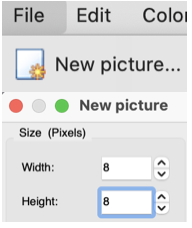 The goal is to create a clean design outline forming shapes that may be filled in to yield the secondary tiling designs.
The goal is to create a clean design outline forming shapes that may be filled in to yield the secondary tiling designs.
To zoom in or out in ArahPaint: use Shift+ or – on Mac, click on the magnifying lens icons in the toolbox,  use the command key and roll the mouse wheel or scroll along the vertical center line of the mouse, or press any number from 0-9 on the keyboard to change zoom directly to that level (1 means 100%, 6 means 600%, O means 1000%).
use the command key and roll the mouse wheel or scroll along the vertical center line of the mouse, or press any number from 0-9 on the keyboard to change zoom directly to that level (1 means 100%, 6 means 600%, O means 1000%).
In RGB mode even if the shapes are drawn in black, when converted to indexed BW some pixels will be lost. If any lines are broken, control in using the bucket fill tool on only selected areas is lost.
To begin with, set the number of colors and the pencil size to one pixel 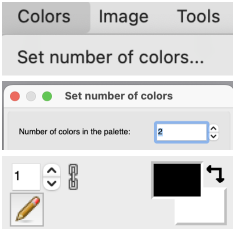 Use the draw circle tool, and select drawing from the center
Use the draw circle tool, and select drawing from the center 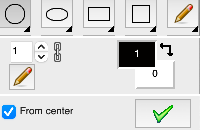 Draw a quarter circle starting on the bottom right of the square, and ending in the center of this image. In this case, there will be 4 white pixels on the left of the line, half the diameter of the planned circle. Click on the pencil tool to set the image.
Draw a quarter circle starting on the bottom right of the square, and ending in the center of this image. In this case, there will be 4 white pixels on the left of the line, half the diameter of the planned circle. Click on the pencil tool to set the image.  Repeat the Process, drawing a mirrored image beginning on the upper left pixel position, and ending in the center of the image as well
Repeat the Process, drawing a mirrored image beginning on the upper left pixel position, and ending in the center of the image as well 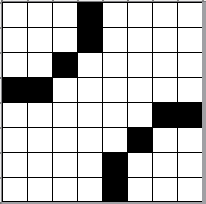 Open the drawing in the repeat window
Open the drawing in the repeat window 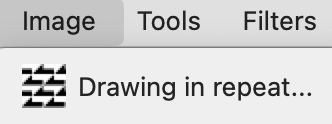 and set the number of repeats vertically and horizontally, done here first in standard alignment. Do not click on random, select new picture, OK. If satisfied, save the png.
and set the number of repeats vertically and horizontally, done here first in standard alignment. Do not click on random, select new picture, OK. If satisfied, save the png.  Undo may be used to revert to the original file unless new picture was left unchecked.
Undo may be used to revert to the original file unless new picture was left unchecked.
For the Smith tile repeat, do click on random to apply different rotations of the repeat.
Load the 8X8 file
Zoom out to check the pattern and view changes adequately
Open the draw in repeat window
Click on random, and the proposed rotations will appear as symbols,  click on new picture and then on OK to view the result, a file that will now be 32X48 pixels. The result can be saved.
click on new picture and then on OK to view the result, a file that will now be 32X48 pixels. The result can be saved. ![]() To preview other arrangements:
To preview other arrangements:
choose undo, return to draw in repeat, random, preview, and with each repeated click on random a new image will appear on the screen. ![]() At any point select a new picture, OK, and save the result.
At any point select a new picture, OK, and save the result. ![]() The final png for test knitting for my test swatch
The final png for test knitting for my test swatch ![]() Its segments bucket filled with black
Its segments bucket filled with black ![]()
 If bucket fill fails selectively and floods the whole image, return to drawing in repeat and click on close. Return to the image and continue the fill-in process.
If bucket fill fails selectively and floods the whole image, return to drawing in repeat and click on close. Return to the image and continue the fill-in process.
Developing a larger repeat to select an area of interest while keeping in mind the maximum needle width of 200. This repeat is perhaps usefully cropped to blanket size.  Seeking a shorter and narrower motif for a scarf, in the range of 60 to 100 pixels in width that may not require too many tracks when programming the 930, the same 32X48 design is drawn in repeat X4 in width, X2 in height to 128X96 pixels.
Seeking a shorter and narrower motif for a scarf, in the range of 60 to 100 pixels in width that may not require too many tracks when programming the 930, the same 32X48 design is drawn in repeat X4 in width, X2 in height to 128X96 pixels.  The above is split directly in half vertically for this exercise, rendering two files, each composed of 64X96 pixels. The left half,
The above is split directly in half vertically for this exercise, rendering two files, each composed of 64X96 pixels. The left half,  and the right
and the right  Checking vertical alignments
Checking vertical alignments  and committing to the one on the right for the test swatch, knitting on 60 stitches for 120 design rows, using KCI, and starting with dark color from left.
and committing to the one on the right for the test swatch, knitting on 60 stitches for 120 design rows, using KCI, and starting with dark color from left.  That shape in blue that looks almost rectangular is actually not quite circular in the repeat, seen here color-reversed on the bottom right, with the definition also slightly lost in the knit due to the stitch size and birdseye stitches twist.
That shape in blue that looks almost rectangular is actually not quite circular in the repeat, seen here color-reversed on the bottom right, with the definition also slightly lost in the knit due to the stitch size and birdseye stitches twist.  Comparing the 3 swatches in scale and shape definition:
Comparing the 3 swatches in scale and shape definition:  A tiny repeat formed with a thicker line
A tiny repeat formed with a thicker line 
![]() Drawn in random repeat
Drawn in random repeat 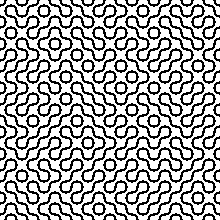 Dividing shapes into symmetrical segments is easy after configuring grid properties, in this case into thirds
Dividing shapes into symmetrical segments is easy after configuring grid properties, in this case into thirds  12X12 in repeat
12X12 in repeat  adding an outline to change the weight of the lines by a single pixel all over without using more specific options
adding an outline to change the weight of the lines by a single pixel all over without using more specific options 
 Using the filled in double circle
Using the filled in double circle  18X18 repeats
18X18 repeats ![]()
![]() drawn in repeat
drawn in repeat  While the definition of true circular shapes may be an issue for some when knitting the Smith variant, others may enjoy variations made by playing with other shapes and angles, here a 16-pixel square was divided into quarters
While the definition of true circular shapes may be an issue for some when knitting the Smith variant, others may enjoy variations made by playing with other shapes and angles, here a 16-pixel square was divided into quarters 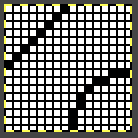
![]()
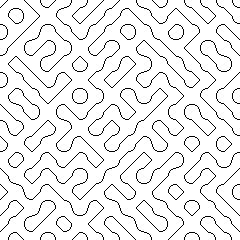 adding a single pixel contour
adding a single pixel contour  combining quarter circles sith full squares
combining quarter circles sith full squares 
![]()
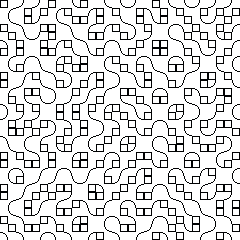 Building larger repeats with interwoven intersections
Building larger repeats with interwoven intersections ![]()
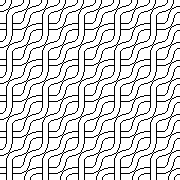
![]()

 Playing with adding colors. In many instances when tiles are drawn in repeats requiring rotations of the original file, coloring in needs to be done after the final image has been composed.
Playing with adding colors. In many instances when tiles are drawn in repeats requiring rotations of the original file, coloring in needs to be done after the final image has been composed. 

 Color exchanging fine black outlines to white, or filling the white background with black in order to reduce files for knitting no more than 3 colors per row.
Color exchanging fine black outlines to white, or filling the white background with black in order to reduce files for knitting no more than 3 colors per row.  The more complex designs become exponentially larger, require electronic downloads, and must meet the limitations of machine memory. The maximum equivalent for pixel per stitch is 200 pixels in width on 4.5 mm knitting machines, and 180 for Passap, with the possibility of separating the width and length into panels for large pieces ie tapestries, or blankets. Long vertical design segments, depending on their height, may also need to be separated in steps for programming them to produce narrow, long, pieces such as scarves or shawls.
The more complex designs become exponentially larger, require electronic downloads, and must meet the limitations of machine memory. The maximum equivalent for pixel per stitch is 200 pixels in width on 4.5 mm knitting machines, and 180 for Passap, with the possibility of separating the width and length into panels for large pieces ie tapestries, or blankets. Long vertical design segments, depending on their height, may also need to be separated in steps for programming them to produce narrow, long, pieces such as scarves or shawls.
The truchet triangles pose a different issue in knit design.
Quilters are familiar with block designs easily found in print and online that technically may be broken down into triangular blocks joined and meeting to form sharp points.  Truchet in his publication used half-square triangles
Truchet in his publication used half-square triangles  and assigned letters to the segments,
and assigned letters to the segments,  providing alphabetical references in illustrations for the permutations,
providing alphabetical references in illustrations for the permutations,  all far easier to achieve nowadays with the aid of software.
all far easier to achieve nowadays with the aid of software.
In ArahPaint, begin with choosing a square size, in this instance, 8 pixels by 8 pixels, matching that in the exercise using circles, and draw a triangle filling the canvas from corner to corner ![]() Drawing in repeat, the choice is made to repeat the triangles twice in both width and height, the preview symbols for the rotations of the shape are illustrated pointing in the same direction by default.
Drawing in repeat, the choice is made to repeat the triangles twice in both width and height, the preview symbols for the rotations of the shape are illustrated pointing in the same direction by default. 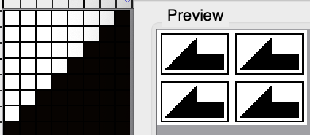 Clicking on any of those half-arrow shapes will rotate the specific shape in the tiled design, this becomes an action that may be influenced manually.
Clicking on any of those half-arrow shapes will rotate the specific shape in the tiled design, this becomes an action that may be influenced manually.  Selecting new image will render this,
Selecting new image will render this,  which illustrates what happens when those triangles are used in knit motif designs. Inevitably, there will be areas where corner pixels meet to join others and the choice will need to be made between using the original or the color-reversed version of the repeat.
which illustrates what happens when those triangles are used in knit motif designs. Inevitably, there will be areas where corner pixels meet to join others and the choice will need to be made between using the original or the color-reversed version of the repeat. ![]() Designing for a maximum 200-pixel design, the number of available needles on Japanese knitting machines, and continuing with random selections, paste 25 times in each direction, ultimately saving one of the new images:
Designing for a maximum 200-pixel design, the number of available needles on Japanese knitting machines, and continuing with random selections, paste 25 times in each direction, ultimately saving one of the new images:
 its color reversed version
its color reversed version  Deciding on the first, an isolated area can be cropped to be used in an accessory ie a 72-stitch scarf, retaining full triangles, using the full 200-pixel height.
Deciding on the first, an isolated area can be cropped to be used in an accessory ie a 72-stitch scarf, retaining full triangles, using the full 200-pixel height.  Wanting to retain a 96-row max height for use on the 930, what happens when repeats line up vertically? the isolated 72X96 design
Wanting to retain a 96-row max height for use on the 930, what happens when repeats line up vertically? the isolated 72X96 design  The assumption is that any change in vertical simple repeats will line up forming new triangles at the intersections not visually interpreted as patterning errors, the above repeated 3 times in height to 72X288
The assumption is that any change in vertical simple repeats will line up forming new triangles at the intersections not visually interpreted as patterning errors, the above repeated 3 times in height to 72X288  Committing to a test swatch: the wool ply is 2/13, and the space dyed rayon 20/2 and thinner in appearance. The contrast is not high, to begin with, and since the sample is knit as DBJ, as a result of the difference in yarn thickness the dark color bleeds through behind the lighter, reducing that contrast even further.
Committing to a test swatch: the wool ply is 2/13, and the space dyed rayon 20/2 and thinner in appearance. The contrast is not high, to begin with, and since the sample is knit as DBJ, as a result of the difference in yarn thickness the dark color bleeds through behind the lighter, reducing that contrast even further.
The places where the single pixels at the individual shape corners meet other shapes in the repeat can still be easily located.
The sample repeat size is 68X96 pixels, designed to include 2-stitch vertical borders drawn with dark pixels,  the knit carriage was set to KCII, which allows the formation of distinct single color edges
the knit carriage was set to KCII, which allows the formation of distinct single color edges 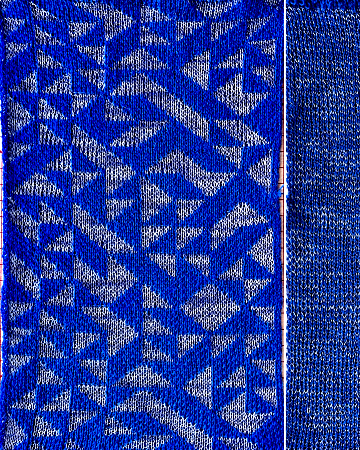 Another alternative: beginning with a 9X9 repeat,
Another alternative: beginning with a 9X9 repeat,  drawn in repeat to 225X225, shapes do not touch in this rendering,
drawn in repeat to 225X225, shapes do not touch in this rendering,  but do if color-inverted.
but do if color-inverted.  Isolating a repeat from the “floating” triangles, 45X81
Isolating a repeat from the “floating” triangles, 45X81 ![]() tiled X3 to 45X243 may look ok
tiled X3 to 45X243 may look ok ![]() but aside from the issue of choosing visually floating shapes vs still touching ones,
but aside from the issue of choosing visually floating shapes vs still touching ones, 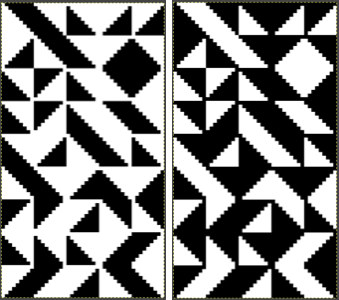 the big problem to be considered is the fact that for the machine KRC color separation to happen correctly, the repeat downloaded must be an even number of rows. A workaround may be to double the original height to 162 rows prior to programming it since one cannot use double height and KRC buttons at the same time in many machine models. Pursuing personal preferences can be endless. I am increasingly fond of the repeat that began with the 8X8 square.
the big problem to be considered is the fact that for the machine KRC color separation to happen correctly, the repeat downloaded must be an even number of rows. A workaround may be to double the original height to 162 rows prior to programming it since one cannot use double height and KRC buttons at the same time in many machine models. Pursuing personal preferences can be endless. I am increasingly fond of the repeat that began with the 8X8 square.
Working with quarter-filled segments: multiplied by 20 in each direction to a 200-pixel repeat. 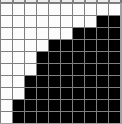
![]() Drawn using random/ preview/ prior to saving the file
Drawn using random/ preview/ prior to saving the file 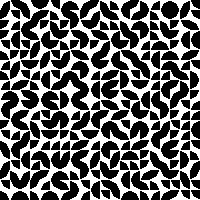 Its color reversed view
Its color reversed view 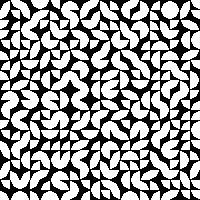
Truchet tiling design inspiration 1
For many years my knitting of accessories and wearable pieces was my source of income, guided by what pricing the local market would bear, the limitations of mylar sheets or that of an early Passap interface to program repeats, and the amount of time required to complete each piece.
There is practicality and ease in playing with colors using small motifs single-bed, and varying materials and yarn plies allowed me to aim for limited edition designs without looking at identical finished products more than once or occasionally a few times.
At first, Ayab and then img2track changed the playing field in terms of downloading and programming designs.
Eventually, my knitting moved from production pieces for sale to creating samples for my blog almost exclusively.
I have had a long and continued interest in math-based designs, and knit a line of accessories using automata-inspired repeats, often limiting the repeats in size to ones that would align vertically without having to program multiple DBJ segments, reducing the possibility of programming errors in scarves that would often require around 1200 knit rows in length.
A 930 followed the 910, this, knit in July 2021, was my first try at using img2track to download multiple tracks.  There are many ways to yield math-based patterns, and nowadays online generators and reference sites abound, making it possible for nongeeks to use the resulting files to create knit suitable designs.
There are many ways to yield math-based patterns, and nowadays online generators and reference sites abound, making it possible for nongeeks to use the resulting files to create knit suitable designs.
Some recent Truchet tile images shared on Instagram brought me back to exploring math-based images and what by default needs to be executed as larger-scale design motifs in knitting.
Sebastian Truchet was a Carmelite priest whose “Memoir sur les Combinasions” was published in 1704. It is a wealth of patterns built up from a simple motif, which you can see here
http://gallica.bnf.fr/ark:/12148/bpt6k3486m.image.f526.langFR and in which he discussed squares, half black, half white, split into triangles, with four possible orientations for each tile. He was also the inventor of the point system for indicating the sizes of typeface fonts.
His method of tiling by the combination of manipulating four-letter codes, A, B, C, and D, in rotations using triangular shapes inspired new variations in tilings.
Cyril Stanley Smith introduced two alternatives to the basic Truchet tile in 1987. One uses only diagonal lines to create maze-like designs where the coloring is removed and only the boundaries remain. The other, resulting in the designs produced in this post, uses quarter circles that may be filled or used as outlines and rotated to form the final shapes. ![]()

 Distinctions in naming the tiles are not often made. “Truchet” is the commonly used generic term.
Distinctions in naming the tiles are not often made. “Truchet” is the commonly used generic term.
Some articles on the tilings:
Generalizations of truchet tiles, Multiscale Truchet Patterns, The Tiling Patterns of Sebastien Truchet and the Topology of Structural Hierarchy, and More on tiles, fun with portraits.
Basic elements include contrasting triangles, quarter circles, and diagonal lines.
One may find code for programming DIY in various GitHub links. Python is far beyond my interest or skill, there are many ways to achieve the designs.
Spreadsheets are also programmable, but require the development of formulas.
Developing patterns from online sources, beginning with the Smith variation using quarter circles: the Wolfram site is a computing and math one well worth exploring, the files there are Computable Document Files, a document standard developed by Wolfram Research. They can be saved and opened using the Wolfram CDF Player, which is a standalone application and a Web browser plug-in provided for free.
To preview search results in a browser: https://demonstrations.wolfram.com/TruchetTiles/.
Ad blockers may interfere with proper previews in Safari but appears to not be an issue using Chrome as the browser.
Files cannot be saved from the preview results other than as screengrabs.
What is cdf
For permanent access to preferred CDFs:
CDF Wolfram player download is available for Mac and Windows, you will be asked to provide an email address.
After the player is installed and opened, click on the central option, 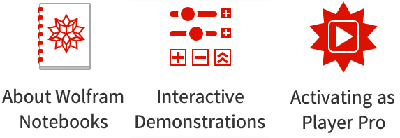 and search for your area of interest.
and search for your area of interest.  Any demonstration may be saved for future use, most are customizable to varying degrees.
Any demonstration may be saved for future use, most are customizable to varying degrees.
In my first effort, I used colors and left the black outlines. The second, simpler method of editing follows below it.  The swatch png, 58X150, includes 2 stitch vertical borders in the dark color. The machine was set to the built-in KRC color separation for DBJ. Some of the circular shapes have been already edited, but if I were to reuse the repeat, I would clean up more of the design shape edges
The swatch png, 58X150, includes 2 stitch vertical borders in the dark color. The machine was set to the built-in KRC color separation for DBJ. Some of the circular shapes have been already edited, but if I were to reuse the repeat, I would clean up more of the design shape edges
160 design rows were knit, measuring 7.5 inches by 20.5.
The dark color is a chenille from an unmarked cone with uncertain yardage. The space-dyed is an 8/2 rayon slub.
Tension was set at 5/5, the knit carriage on KCI, and the ribber using lili buttons for birdseye backing. KCII may be used as well if preferred, the side vertical edges will have a slightly different appearance. 
 Developing an added repeat:
Developing an added repeat:
the working file in the cdf is a default 600 by 600 pixels. If the goal is to save a black-and-white downloadable png, the present plan is to fill in portions of the design with black while leaving others in white.
Checking tiling insures continuous designs at any point in the process.
It is possible to directly scale size in the cdf, but the shape outlines become broken in the automatic % reduction, so the filling-in process I suggest fails to be contained. 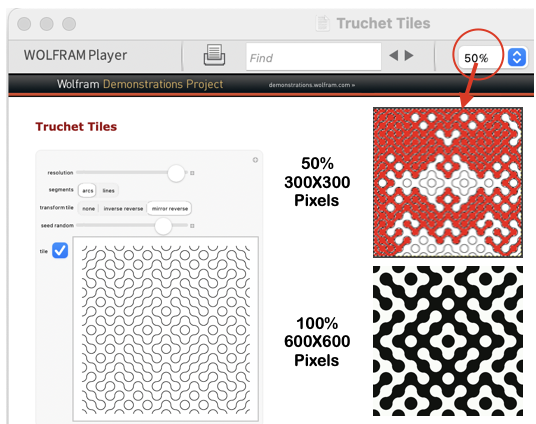 In this exercise, none of the other available parameters were changed. When the player is launched, click on the tile, it will be surrounded by an orange line,
In this exercise, none of the other available parameters were changed. When the player is launched, click on the tile, it will be surrounded by an orange line,  copy the image, and it can then be pasted directly into Gimp.
copy the image, and it can then be pasted directly into Gimp. 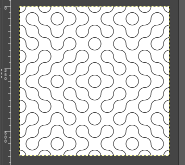 Change the Image Mode to BW Indexed before proceeding further.
Change the Image Mode to BW Indexed before proceeding further.
Using the fuzzy select tool  click on any area in the design, it will be surrounded by dotted lines
click on any area in the design, it will be surrounded by dotted lines  select bucket fill, to fill the selected area with black.
select bucket fill, to fill the selected area with black.
Edit, undo will revert to the previous steps in sequence at any point.
If satisfied, select the rectangle tool.
Clicking on the selected area 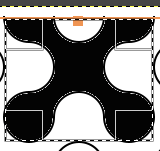 will allow its use for copying and pasting the outlined segment on a new canvas or cropping the area to the selection for saving while clicking anywhere in the Gimp work window fixes the results. The dotted lines disappear. Repeat the process on the remaining image.
will allow its use for copying and pasting the outlined segment on a new canvas or cropping the area to the selection for saving while clicking anywhere in the Gimp work window fixes the results. The dotted lines disappear. Repeat the process on the remaining image.  The processed file will measure 600X600 pixels.
The processed file will measure 600X600 pixels.
Anyone working with large-scale images and reducing file size to make them available for knitting as single panels on a standard machine is familiar with the loss of detail and the need for cleanup of edges as incremental decreases in file size are attempted.
Magnifying any of these will help evaluate forms and scaling decisions for final repeats to be used in knit test swatches.
Downloading or copying and pasting them from here for personal use may change the image mode to RGB in the process, check mode and convert them to indexed BW if needed before any further use.
300X300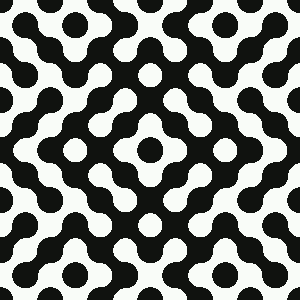 200X200 pixels
200X200 pixels  150X150 pixels
150X150 pixels 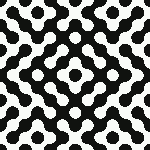
 The proof of concept was knit using the 100X200 repeat without any pixel cleanup.
The proof of concept was knit using the 100X200 repeat without any pixel cleanup. 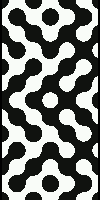 The blue yarn is a 2/20 wool, and the white is a 2/28 Italian yarn of unspecified fiber content from my stash. Both beds were set at 2/2. The KRC setting separated the colors so each color in each row knits only once, but it takes 2 passes to complete one row, so 100 design rows translate to 200 rows of knitting. In this instance, img2track used on the 930 broke up the design into 2 tracks, a 66-row first track, followed by a 134-row one.
The blue yarn is a 2/20 wool, and the white is a 2/28 Italian yarn of unspecified fiber content from my stash. Both beds were set at 2/2. The KRC setting separated the colors so each color in each row knits only once, but it takes 2 passes to complete one row, so 100 design rows translate to 200 rows of knitting. In this instance, img2track used on the 930 broke up the design into 2 tracks, a 66-row first track, followed by a 134-row one.
Each track needed to be programmed sequentially.
The ribber was set for birdseye backing, which in this case results in an interesting shadowing of the pattern 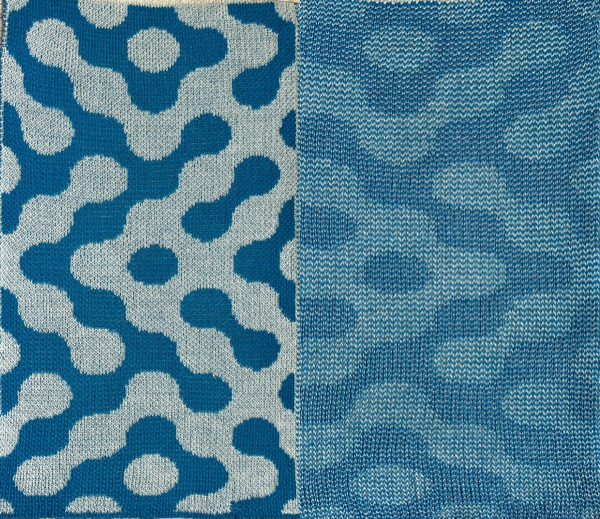 Comparing the two swatches:
Comparing the two swatches:  Variations in tiles made by changing variable view options
Variations in tiles made by changing variable view options  will still align when combined, easily producing a range of new designs at merging points. Use guides to help narrow down segments of interest, here they are placed at even 100-pixel intervals on two adjoining 600-pixel images.
will still align when combined, easily producing a range of new designs at merging points. Use guides to help narrow down segments of interest, here they are placed at even 100-pixel intervals on two adjoining 600-pixel images. 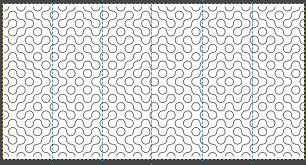 To remove a single guide after placing it, go to Edit, Undo Add the Horizontal or Vertical Guide. To remove all guides, go to View, and uncheck Show Guides.
To remove a single guide after placing it, go to Edit, Undo Add the Horizontal or Vertical Guide. To remove all guides, go to View, and uncheck Show Guides.
And for those not averse to developing any larger motifs from scratch, the limitations of any geometric shape, when reduced to low-resolution knitting, mean the search must begin for what one determines to be a pleasing circular form.  My original circle was placed on a 40X40 grid with outlines every 10 cells, the central circular 20X20 repeat was isolated and split into quarters, in turn generating these 2 tiles out of the 8 total required, also 20X20, with the second the color-reversed image of the first.
My original circle was placed on a 40X40 grid with outlines every 10 cells, the central circular 20X20 repeat was isolated and split into quarters, in turn generating these 2 tiles out of the 8 total required, also 20X20, with the second the color-reversed image of the first. ![]()
![]() A similar approach can be used in color to visualize the initial 8 tile repeats and their rotations in order to form new shapes. This technique may be useful in planning floor tile patterns but is cumbersome for developing knit designs.
A similar approach can be used in color to visualize the initial 8 tile repeats and their rotations in order to form new shapes. This technique may be useful in planning floor tile patterns but is cumbersome for developing knit designs. 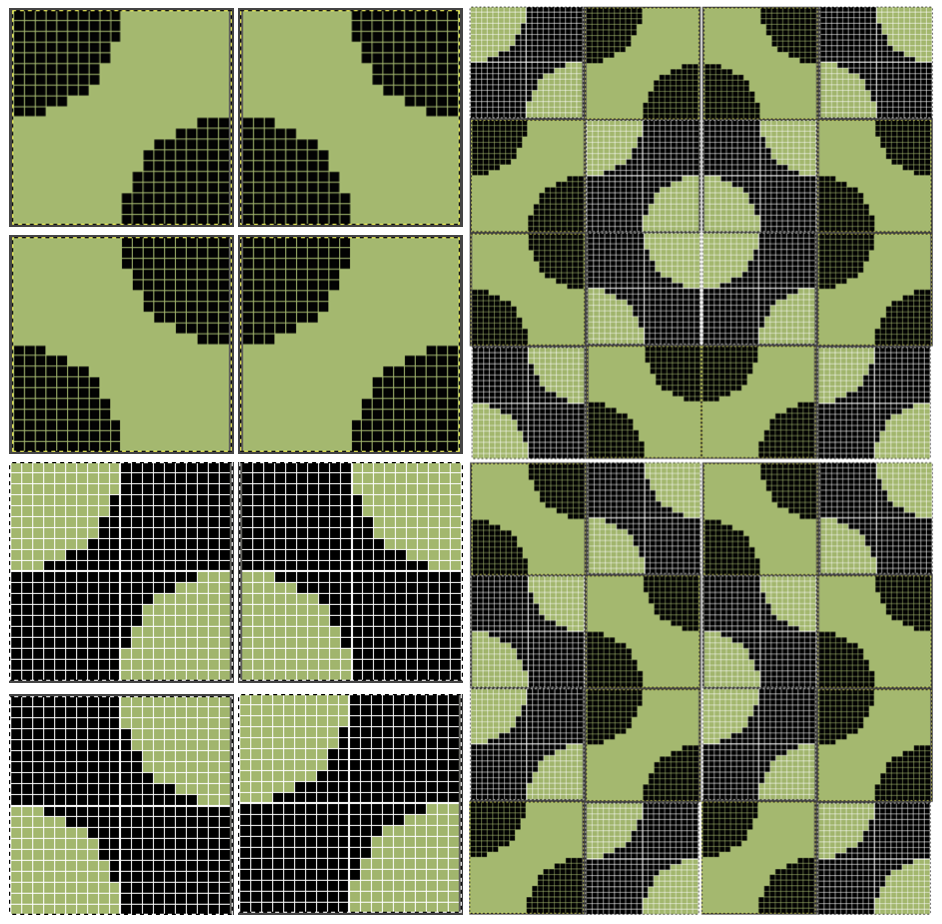 Facilitating and speeding up the process: in my post on using ArahPaint and Gimp in knit design, I briefly touched on the Drawing-in-repeat feature in Arah to produce random tiling.
Facilitating and speeding up the process: in my post on using ArahPaint and Gimp in knit design, I briefly touched on the Drawing-in-repeat feature in Arah to produce random tiling.
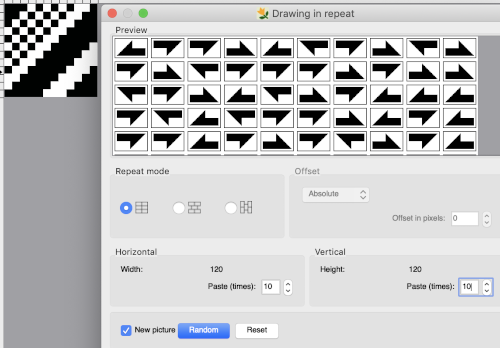 Thanks to the developer there now is a video, viewable on Instagram and Facebook, on how to use the feature for this type of tile, which allows for very quick DIY versions that can be trimmed as needed for knitting. This is my very first try, a how-to will follow in the next post.
Thanks to the developer there now is a video, viewable on Instagram and Facebook, on how to use the feature for this type of tile, which allows for very quick DIY versions that can be trimmed as needed for knitting. This is my very first try, a how-to will follow in the next post. 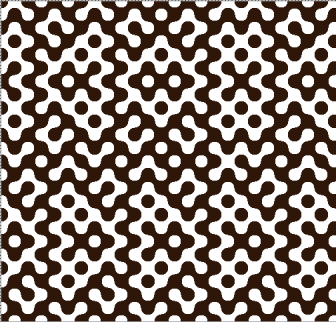 And the second, composed of triangular forms
And the second, composed of triangular forms For spreadsheet users, this one generates the various tiles in Google Sheets and a related article.
For spreadsheet users, this one generates the various tiles in Google Sheets and a related article.
Another racking tale: Passap/Brother 5
I taught in a design school in a lab with Brother Punchcard models, four 910s, and 2 bulky machines. My previous experience had been using Passap and Studio electronics, and a crash course in Brother models followed my being hired.
My E 6000 was purchased from a sewing machine center at a time when the owner decided knitting was not for her.
The 560 Studio model was later upgraded with a change in their box in exchange for my publishing some patterns for the Studio Design Magazine but was sold years ago.
There were years the Passap was my production machine for garments and accessories knit double-bed. Single-bed knits for the same end use were easier to knit on Brother, with a clear view of stitch formations vs the issues with seeing the fabric or correcting errors when working with the ribber in place.
The immediacy of easy testing with img2track on the 930 results in nearly all of my recent blog swatches.
There are still days I admit I do love the E6. The console commands along with the lock setting and pusher options on the back bed make a range of fabrics possible that are far harder to achieve in Japanese model KMs.
Looking back, these are some of my previous shares including Passap mentions
Machine cross reference chart 3/18
Brother/Passap: traveling between brands 11/18
Pile knitting on Passap/ Brother KMs 4 1/20
A racking tale: Passap/Brother 3 9/19
Translating Passap model book pattern/use on Brother 1 8/19
Fisherman_ English tuck stitch rib 1_ checks patterns_ Brother, Passap 10/18
Tubular machine knit fabrics: fair isle, Brother/Passap 11/17
Pile knitting on Passap and Brother KMs 2 7/15
Pile knitting on Passap, Brother, and Studio KMs 1 7/15
Drop stitch lace, 2 colors per row, Passap KM 10/13
Back to leaf lace, add rib, and take it to the Passap 3/12
Japanese punchcard motifs used in Passap E 6000 machines 4/11
FB shares have led me down rabbit holes I may not otherwise have entered.
In the machine knitting group, someone recently shared a series of scarves knit using the E6, providing the Duo80 diagram and the E6 technique number. The setup is for a 2/2 rib, reverses the pusher positions, but produces the same knit Duo 80 symbols
Duo 80 symbols 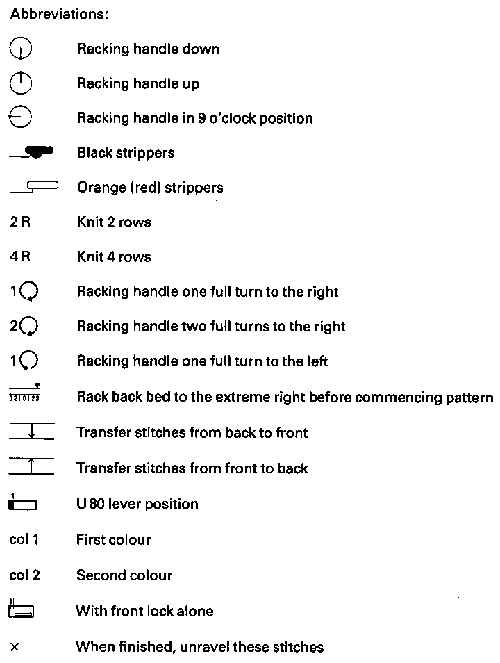 AX = Tuck, setting is the same in both the Duo and the Passap back locks
AX = Tuck, setting is the same in both the Duo and the Passap back locks
AX serves the same function in the Duo, and is replaced by KX on the E6 front lock
The arrow keys on the back lock work the same on both machines.
Passap preselects and works on pushers initially placed in work or rest on both beds, whether manually or by console selections in the E6.
Brother preselects needles in the planned pattern on the knit bed subject to punched holes or programmed pixels, but not on the ribber, other when using lili buttons, and that comes with rules and the sole automatic repeat ie the that the number of needles in use on the ribber must be even.  On the Passaps there are no such rules on the back bed.
On the Passaps there are no such rules on the back bed.
With no arrow keys selected the same action is repeated until the lock setting is changed, so in the above, the change is made by manually setting the back lock to N for 2 rows, then back to AX for tuck on both Passap models.
The front bed in the Duo also has a fixed pattern selection, requiring the lock change to N there as well. The E6 built-in pattern selects the all-knit rows, so its lock remains in the KX setting.
The initial pusher setup is manual on both models but not location-dependent in this particular design.
The E 6 console will select the proper pattern based on the pushers in the work position. A look at pusher positions from the E6 manual. Each machine brand has its own specific vocabulary for parts and techniques. 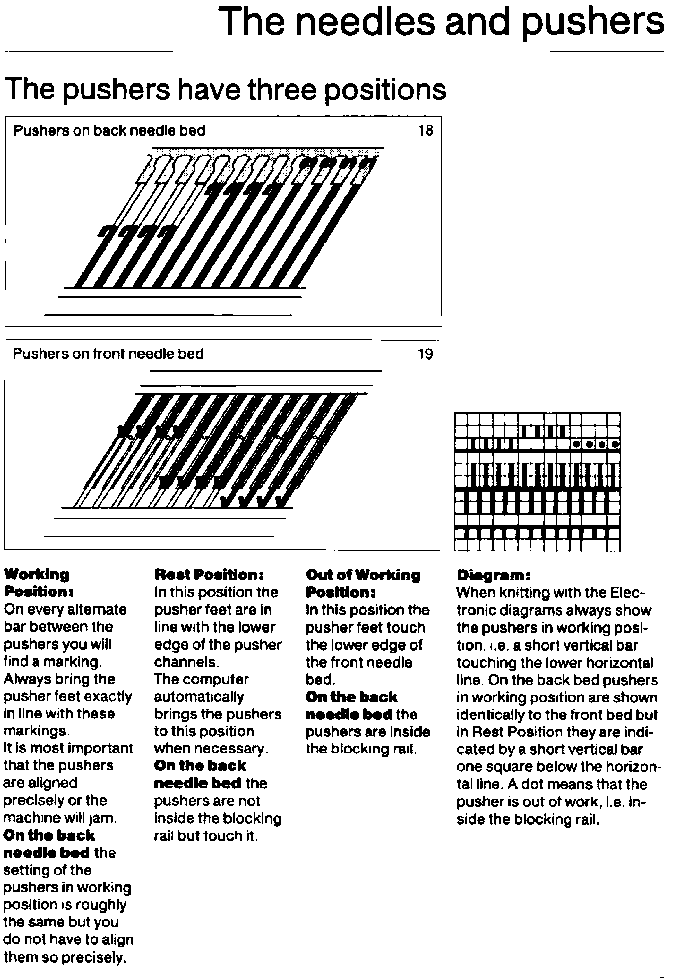 Things get a little more complicated on Brother, it is helpful to have an understanding of stitch formation on both beds before tackling more complex knits.
Things get a little more complicated on Brother, it is helpful to have an understanding of stitch formation on both beds before tackling more complex knits.
In Brother the needle placement on the main bed matters as it does in tuck lace, so it needs to be verified before any knitting. “Air knitting” is one easy way to do that. Rows 5 or 6 would provide the necessary preselection.
In any punchcard model or Japanese electronic machine, the knitter is usually in charge of keeping track of racking. The E6 provides console prompts for racking positions in this design, facilitating the process.
An attempt to visualize what actions need to happen on the Brother models: the needle setup will match the Duo or the rotated E6 version  Considering the required patterning for each bed, empty columns in my charts represent needles that need to be pushed back to A and left out of work on both beds. Textured ladder spaces will not be formed on either bed as is seen when using similar repeats on the single bed.
Considering the required patterning for each bed, empty columns in my charts represent needles that need to be pushed back to A and left out of work on both beds. Textured ladder spaces will not be formed on either bed as is seen when using similar repeats on the single bed. 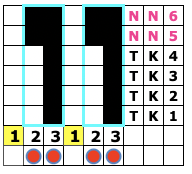 Adding the ribber position and configuration
Adding the ribber position and configuration  The top bed can be programmed, this 24-stitch version is suitable for use in punchcard machines.
The top bed can be programmed, this 24-stitch version is suitable for use in punchcard machines.  The main bed will knit all needles programmed with punched holes or black pixels and will tuck unpunched squares or white pixels.
The main bed will knit all needles programmed with punched holes or black pixels and will tuck unpunched squares or white pixels.
The ribber requires setting changes after the initial four and after the last 2 rows of each 6-row repeat.
In addition, there are racking changes after each repeating segment.
In this setup, there will be a knit stitch beside each tuck one up to the all knit rows, helping to anchor the tuck loops. Ribber carriage settings are noted. 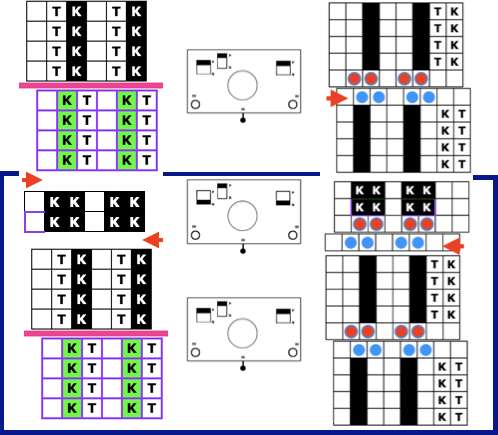 Anytime there are needles out of work, cancel the end needle selection. Depending on the machine model being used the repeat may need to be mirrored horizontally to match my in-process photos, true in my 930.
Anytime there are needles out of work, cancel the end needle selection. Depending on the machine model being used the repeat may need to be mirrored horizontally to match my in-process photos, true in my 930.
Using design row 5 or 6, air knit a row to find needles that need to be in work on the knit bed. Push non-selected needles out of work, and back to the A position. After doing so, reset the pattern to design row one.
The setting for the racking indicator does not specifically matter. It is often best to consider this before casting on. Here racking is only by one position, avoid 1 or 10. Starting at 5 centers stitches in relationship to each other stitches. As knitting progresses, where the ribber needle positions become obvious and less reliant on checking numbers.  Cast on bringing appropriate needles into work on the ribber.
Cast on bringing appropriate needles into work on the ribber.
The original needle setup. 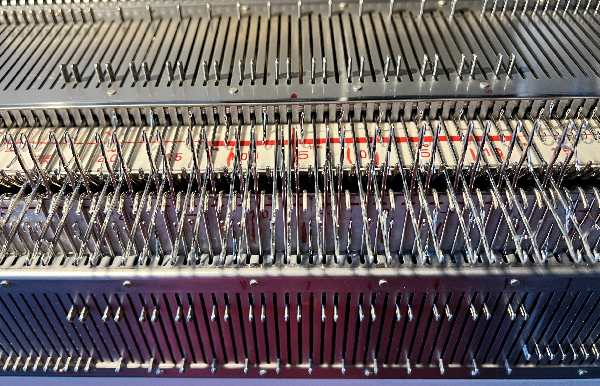 Use any favorite cast-on method.
Use any favorite cast-on method.
Starting side does not matter unless one is planning on using a color changer, in which case the first preselection row needs to happen from right to left.
Since needles will be manually pushed up to the hold position, make certain that the ribber carriage is not set to hold.  In a test swatch, knit several all-knit rows before beginning the pattern. If planning a piece, start with waste yarn and ravel cord prior to casting on with “garment” yarn.
In a test swatch, knit several all-knit rows before beginning the pattern. If planning a piece, start with waste yarn and ravel cord prior to casting on with “garment” yarn.
A tool that aids in selecting every third needle is extremely helpful  The initial carriage setups used for rows 1-4
The initial carriage setups used for rows 1-4 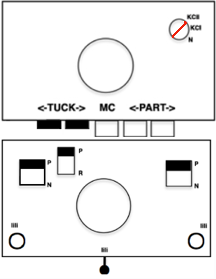 The placement of the first needle on the ribber with respect to that of the first on the main bed
The placement of the first needle on the ribber with respect to that of the first on the main bed  The first needle in each pair of rows on the ribber needs to be brought up to the E position in every row for the first 4 rows of the 6-row repeat, I began with the first ribber needle on the left.
The first needle in each pair of rows on the ribber needs to be brought up to the E position in every row for the first 4 rows of the 6-row repeat, I began with the first ribber needle on the left. 
 The needles brought up to E will knit, and help anchor down the knit bed tuck stitch on their left, and the needles on their right will tuck. In turn, the main bed selected needles will anchor loops formed on the ribber, the nonselected will tuck.
The needles brought up to E will knit, and help anchor down the knit bed tuck stitch on their left, and the needles on their right will tuck. In turn, the main bed selected needles will anchor loops formed on the ribber, the nonselected will tuck.
The appearance after the tuck loops have all been formed and the needles holding them up to that point are preselected forward just prior to the 2 all knit rows.  The knit carriage is left on tuck in both directions, while the ribber is set to knit for 2 rows. It is not necessary to change the P lever to R, with the other buttons set to N, knit is king.
The knit carriage is left on tuck in both directions, while the ribber is set to knit for 2 rows. It is not necessary to change the P lever to R, with the other buttons set to N, knit is king. 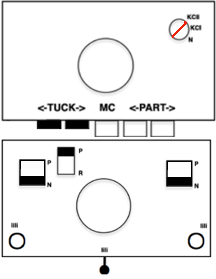 Time to rack so that the first needle on the ribber will now be to the left of the first on the main bed. Push down lightly on the first 2 ribber needles on the left before racking in case those first stitches are a bit snug, to avoid starting needles crashing into each other as you move needle positions.
Time to rack so that the first needle on the ribber will now be to the left of the first on the main bed. Push down lightly on the first 2 ribber needles on the left before racking in case those first stitches are a bit snug, to avoid starting needles crashing into each other as you move needle positions.  Knit 2 rows.
Knit 2 rows.
Rack again to the initial position,  change ribber settings again, and repeat the process as described.
change ribber settings again, and repeat the process as described.  The proof of concept: the error shows what happens when one misses changing the ribber settings back to tuck.
The proof of concept: the error shows what happens when one misses changing the ribber settings back to tuck. 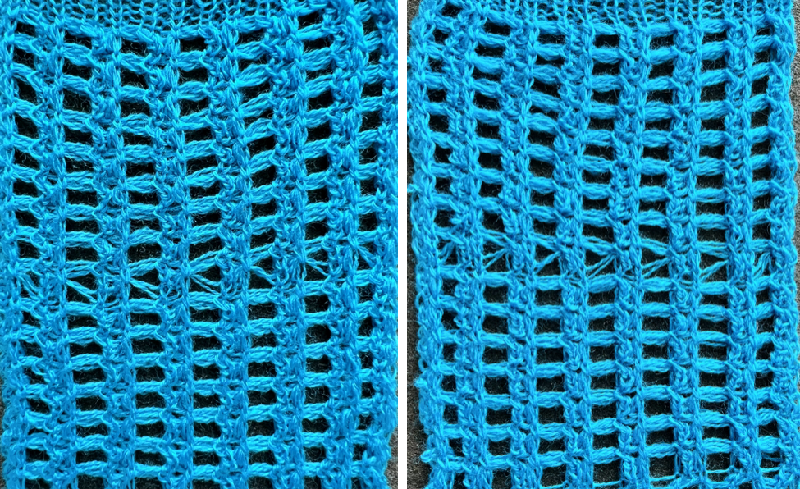 If that is not challenging enough, add a color change, knitting the first 4 rows using color one, and the 2 all-knit rows with color 2.
If that is not challenging enough, add a color change, knitting the first 4 rows using color one, and the 2 all-knit rows with color 2. 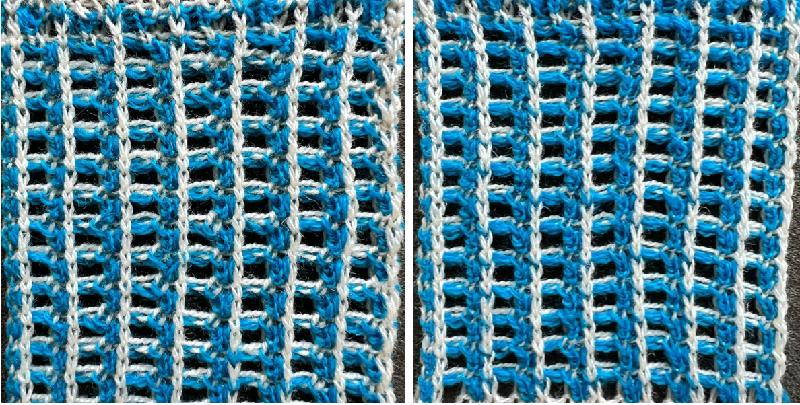 I used to tell my students to develop a sort of tune that could be sung (mentally) as a reminder of the steps in complex fabrics ie bring up 1, 2, 3, 4, rack, change color, change settings, knit 2, rack, change color, change settings, bring up, etc. but my advice if you really want to knit this fabric in a full piece is to borrow and E6 or pay someone else to knit it for you 😉
I used to tell my students to develop a sort of tune that could be sung (mentally) as a reminder of the steps in complex fabrics ie bring up 1, 2, 3, 4, rack, change color, change settings, knit 2, rack, change color, change settings, bring up, etc. but my advice if you really want to knit this fabric in a full piece is to borrow and E6 or pay someone else to knit it for you 😉
Pintucks 2, ripples in knits using the ribber
This content, on a topic I intended to expand on further, had been “tucked” away as a draft last March.
Ripples in knits are created by knitting an unbalanced fabric, with one of the beds knitting more rows than the opposite bed.
Depending on the design, the fabrics may share similarities with blistered stitches DBJ.
Pintucks vs shadow pleats introduces fair isle patterning possibilities on the top bed.
Pintucks are created by knitting on one bed and slipping on the other for often as many as 6-10 rows followed by plain knitting on both beds to seal the fabric together.
Nopps are made in a similar fashion, but using the tuck setting and for fewer rows. Before moving on to exploring added textures, this shares a few of the many options.
Both fabrics may be knit with or without added automatic patterning.
Pintucks tend to be firmer and with less stretch than fabrics using tuck settings.
Some published sources for single-color versions, though intersections could be isolated and horizontal colored stripes continuing on both beds may be introduced:
fromStudio punchcard volumes included samples, calling the fabric punch pin tuck

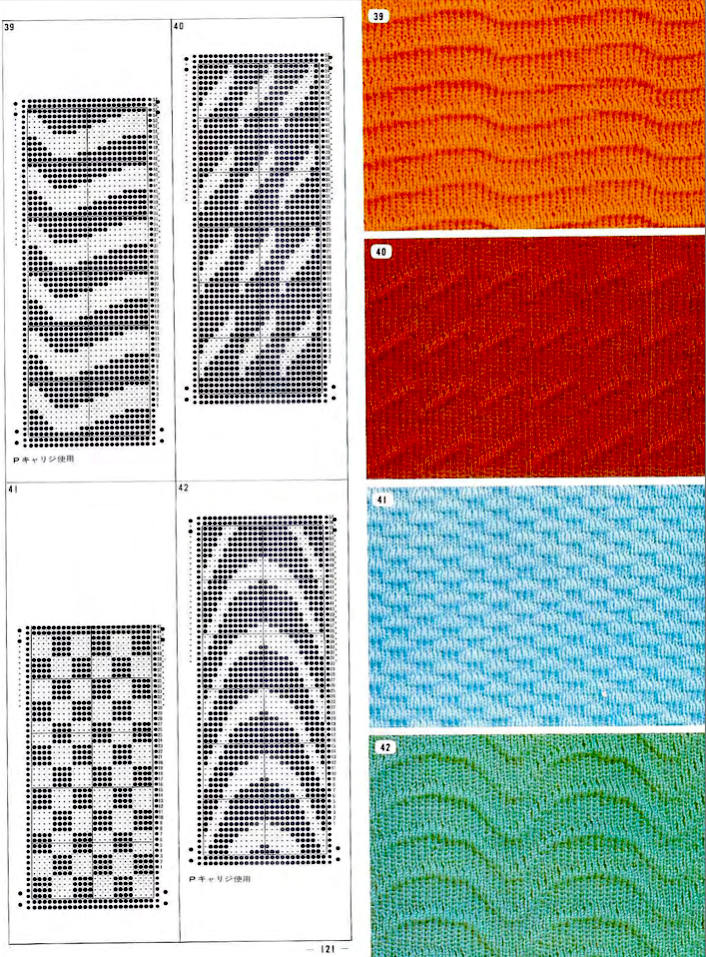 Brother introduced the idea in their Ribber Techniques Book:
Brother introduced the idea in their Ribber Techniques Book: 

 My experience in knitting these fabrics has been using Brother and Passap. In my blog posts, I discuss fabrics and settings I am able to test and reproduce, so specific ones for other machine brands are not usually included for specific techniques.
My experience in knitting these fabrics has been using Brother and Passap. In my blog posts, I discuss fabrics and settings I am able to test and reproduce, so specific ones for other machine brands are not usually included for specific techniques.
In creating DIY textures, an extra needle is generally used on the bed used to knit the sealing rows.
Nonautomated patterning may be created by leaving needles out of work on either bed. Adding racking changes the fabric even further.
If automatic patterning is used along with tuck or slip settings, the end needle selection on the patterning bed is canceled or the needles on either side of the ones out of work will knit the stitches rather than tucking or slipping them.
Many decisions are made in the process, beginning with a simple variation, A, followed by B with a small number of needles out of work on the top bed,
 which will create ladders between knit spaces as would happen in any single-bed knitting.
which will create ladders between knit spaces as would happen in any single-bed knitting.
Switching to needles out of work on the ribber renders the main bed knitting with blocks of pattern and no floats, C.
The remaining pintucks are created with 6 rows of knitting on the top bed. C: racking sequence is by one position in either direction, followed by another pintuck with no racking before every sealing row
D: racking is by one position in each direction, before every sealing row
E: racking by one position X4 before each sealing row, then reversing the sequence in the opposite direction. The effect on the knit side is subtle.  Additional swatch photos in each post
Additional swatch photos in each post
Ribber fabrics produced with 2 knit carriages selecting needles
racking 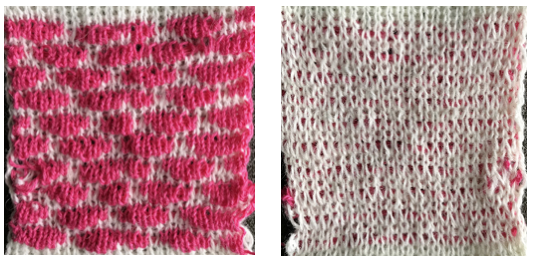 Adding lots of texture: Combining knit carriage needle selection with racking and needles out of work. The surface here is more dramatic, it is best to use yarns with memory such as wool, and to have a memo provided by the machine if possible or some other way to help track the racking sequence without errors in long projects.
Adding lots of texture: Combining knit carriage needle selection with racking and needles out of work. The surface here is more dramatic, it is best to use yarns with memory such as wool, and to have a memo provided by the machine if possible or some other way to help track the racking sequence without errors in long projects. 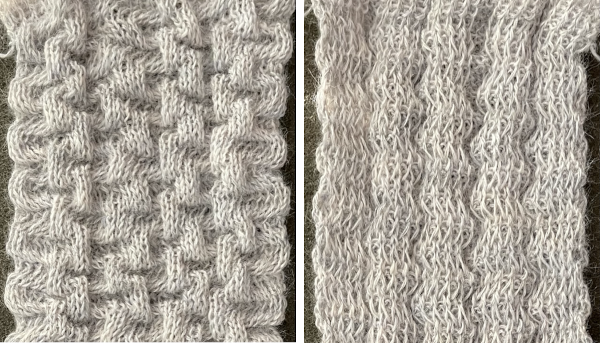 Racking by more positions as well as more knit rows on the top bed.
Racking by more positions as well as more knit rows on the top bed.  Racking: Passap/Brother 3 Combining knit carriage needle selection with racking
Racking: Passap/Brother 3 Combining knit carriage needle selection with racking Adding complexity with transfers from one bed to the other to racking
Adding complexity with transfers from one bed to the other to racking  A Passap special begins with deciding on which bed to produce patterning, at first with manual selection on the back bed, then with a programmed repeat on the front bed, no racking
A Passap special begins with deciding on which bed to produce patterning, at first with manual selection on the back bed, then with a programmed repeat on the front bed, no racking  At the top of the swatch, to secure stitches, a strip of woven interfacing was ironed on, and a zig-zag stitch was added with a sewing machine before further trimming.
At the top of the swatch, to secure stitches, a strip of woven interfacing was ironed on, and a zig-zag stitch was added with a sewing machine before further trimming.
A subtle effect with diagonal pattern movement. More details in the post on diagonal patterning in machine knits. ![]()
 and one with evenly distributed, more pronounced folds
and one with evenly distributed, more pronounced folds ![]()
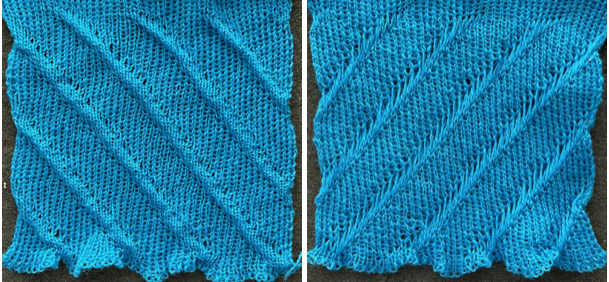
ArahPaint and Gimp in knit design 3
Previously published:
ArahPaint and Gimp in knit design 2
ArahPaint meets Gimp in knit design 1
Subsequent posts on using Gimp Layers to process images:
Using Layers in Gimp for color separations
Layer/Transparency/Color to Alpha Gimp Update for Mac 3_more on color separations
Gimp allows one to work on multiple images with only a single window open, left mouse clicking on any one of the images will bring it into view for editing. In the dark theme, it is hard to see the difference, but a lighter border actually surrounds the active image distinguishing it from the others, outlined here in yellow 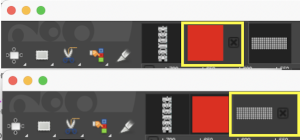 In Arah, multiple windows may be opened at any one time, and left-clicking on any one of them will bring it to the front for editing.
In Arah, multiple windows may be opened at any one time, and left-clicking on any one of them will bring it to the front for editing. 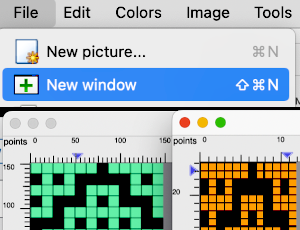 When working using the same file in more than one window, the degree of magnification needs to match in each.
When working using the same file in more than one window, the degree of magnification needs to match in each.
Spreadsheets and paint programs may be used to achieve color separations for designs intended for specialty fabrics, many worked on the double bed.
Two places to begin exploring them here are for knitting single-bed mosaics and double-bed jacquard in its form where each color in each design row knits twice.
It is unlikely to happen often in knitting that more than 6 colors are used in any one fabric except perhaps in an elaborate color-changing fair isle.
The palette that appears in Arah when opening a new file is random, as seen here when two new files of the same size are loaded  If one’s preference is to reduce the number of colors, the specific number may be set by choosing from the colors menu, editing the number identified as that for the working palette, changing it to the new value, in this case, 6, and the palette reduction occurs as seen in A. For most knit repeats a black color is handy, any one of the 6 colors or more may be adjusted as described in the previous post, seen in B, where black has been added, replacing the color in position 1.
If one’s preference is to reduce the number of colors, the specific number may be set by choosing from the colors menu, editing the number identified as that for the working palette, changing it to the new value, in this case, 6, and the palette reduction occurs as seen in A. For most knit repeats a black color is handy, any one of the 6 colors or more may be adjusted as described in the previous post, seen in B, where black has been added, replacing the color in position 1.  More Gimp information: https://docs.gimp.org/2.10/en/gimp-palette-dialog.html
More Gimp information: https://docs.gimp.org/2.10/en/gimp-palette-dialog.html
Some of the related content in brief: the former versions of GIMP had a “Save palette” command. Palettes were stored in a specific folder via the preferences pane. Easy to do and manage. It no longer exists.
To save the palette of an image, indexed or not, you must now import it from the image.
The “Palettes” dialog is dockable: from the Image menu, select Window, Dockable Dialogues, Palettes.
A few dozen more or less randomly chosen palettes are supplied with GIMP.“Import Palette” allows you to create a new palette from the colors in a gradient, image, or palette file.
Right-click in the space to the right of the illustrated palettes to call up the import option, or for palette editing.  It is not necessary to index the image, this image was used in RGB mode.
It is not necessary to index the image, this image was used in RGB mode. 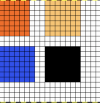 A palette name can be assigned, and if previously used, a number will be appended by the program.
A palette name can be assigned, and if previously used, a number will be appended by the program.
The number of colors: the default is 256, you can set the number to any you choose. Gimp will try to create a palette by spacing the number of colors evenly across the range of the gradient or image. Each screengrab in the top row shows the initial selections for gradient or image, and the second row of screengrabs notes other changes made when choices were available and the results. White dots mark selections as seen while using the program.  Using the same image, indexed to 5 colors, the custom palette is rendered in a one-step process. The gradient seen in the first position on the top left was randomly assigned by the program and does not influence the results.
Using the same image, indexed to 5 colors, the custom palette is rendered in a one-step process. The gradient seen in the first position on the top left was randomly assigned by the program and does not influence the results.  The Columns selection number settings only influence the way the palette is displayed and have no effect on the way the palette is used. The lower the number, the larger the display size of each color unit.
The Columns selection number settings only influence the way the palette is displayed and have no effect on the way the palette is used. The lower the number, the larger the display size of each color unit.
Double-clicking on any palette color will magnify the palette view on the theme color background. Left-clicking on any color makes it available for drawing, the selection will have a dotted bounding line and the selected color will be assigned to the foreground position, ![]()
 Right-clicking on a color results in these options.
Right-clicking on a color results in these options.  The imported palette will be added to the Palettes dialog and is automatically saved in your personal palettes folder when you quit GIMP so that it will be available in future sessions.
The imported palette will be added to the Palettes dialog and is automatically saved in your personal palettes folder when you quit GIMP so that it will be available in future sessions.
In Arah, the color palette will always display the colors of the active layer. The working image contains colors intended for use in my designs. In addition, please see the note from the developer in the comment at the end of the post. 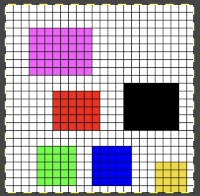 The palette tools:
The palette tools:  A: if you press this icon the program will underline the colors actually used in the image, since all colors are used in this case, each color is underlined in either white or black in this instance
A: if you press this icon the program will underline the colors actually used in the image, since all colors are used in this case, each color is underlined in either white or black in this instance  D: adds color(s) to the palette
D: adds color(s) to the palette  B: removes unused colors in the above palette, it would restore the original colors
B: removes unused colors in the above palette, it would restore the original colors
C: removes duplicate colors, not applicable in this instance
E: removes the last unused color, will not work if all colors are used.
Changing color positions in the palette: to switch the position of two colors in the palette, click the chosen color in the palette, move the cursor to the color you want to switch the position with, and press the left mouse button while holding the Ctrl key on the keyboard. In this instance, the color was duplicated in the new position.  Knitters designing for dbj are likely to work with a limited range of colors, often 3 or 4 max, in specific palette ranges to ready images for download.
Knitters designing for dbj are likely to work with a limited range of colors, often 3 or 4 max, in specific palette ranges to ready images for download.
If color separations for 3 or more colors are done in shades of grey in terms of technical details, you need a pattern image that is 8-bit greyscale, with each color in a range of 8-bit values. So for 4 colors, it would be 0-63 color 1; 64-127 color 2; 128-195 color 3; 196-255 color 4.
Binary images have only 2 possible intensity values, normally displayed as black and white with values of either 1 or 255 for white, and often 0 for black.
That convention may have led to the selection of white as color 1 in automatic separations such as the KRC Japanese one, where white is selected first. In a greyscale or color image, a pixel can take on any value between 0 and 255. 
 Designing for fair isle, or when attempting to visualize and illustrate slip and tuck fabrics with frequent color changes, more colors may be required even though the final download will be in black and white. There is a quick way to add random colors assigned by the program and based on the initial palette:
Designing for fair isle, or when attempting to visualize and illustrate slip and tuck fabrics with frequent color changes, more colors may be required even though the final download will be in black and white. There is a quick way to add random colors assigned by the program and based on the initial palette:  The magic wand tool allows you to work on consistently colored areas without having to select and outline each.
The magic wand tool allows you to work on consistently colored areas without having to select and outline each.
To alter a single color using the bucket tool, click on the wand, then on the color single color area you wish to change, it will become outlined by bounding lines.
Click on one of the colors in the expanded palette, and it will automatically appear in the foreground color position, and it may then be used to bucket fill the chosen area.  Flatten the image using the merge-down tool.
Flatten the image using the merge-down tool.
If the foreground color, in this case, white/0, needs to be changed, in order to choose all pixels in the foreground color, click on the wand, and use Tools > Select by color or Shift+W. This function works only on 8-bit pixel images. Click on the color you wish to use to replace the ground, and bucket fill with the newly selected color. 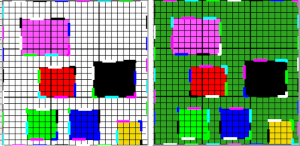 Flatten the image using the merge-down tool.
Flatten the image using the merge-down tool.
Changing multiple color blocks in the same color could be selected by the tool, but filling each of them one at a time was required.  In Gimp a similar tool is the fuzzy select, which also allows for changing the color in a selected area or for selecting and changing all pixels in that color. Selected areas will also be outlined in dashed bounding lines. Bucket fill may then be used to replace color(s). The option is offered to choose either foreground or background for the fill.
In Gimp a similar tool is the fuzzy select, which also allows for changing the color in a selected area or for selecting and changing all pixels in that color. Selected areas will also be outlined in dashed bounding lines. Bucket fill may then be used to replace color(s). The option is offered to choose either foreground or background for the fill. 
 2023 in Gimp 2.10.34 use and hold the shift key prior to selecting and using the bucket fill tool to change all the areas outlined by dashed lines. The bucket-fill tool itself now works again on any area with a defined boundary, no other, following action is necessary.
2023 in Gimp 2.10.34 use and hold the shift key prior to selecting and using the bucket fill tool to change all the areas outlined by dashed lines. The bucket-fill tool itself now works again on any area with a defined boundary, no other, following action is necessary.
Click on the rectangle select tool and then on any spot in the work area or on the image to set the image. The dashed lines will disappear.
In terms of saving the palette in Arah for future use, I saw no specific directions in the manual.
The color palette displayed is always the one used in the active layer. As a workaround: open the image, and the associated palette will be displayed. The repeat begins drawn 24 pixels in width, by 24 in height.
Select clear from the edit menu, or bucket fill area with white
If the size of your intended drawing area is different, choose the option Resize Image from the Image menu. With the chain link intact, the new canvases are created keeping the aspect ratio. Enter a new value for width/height, hit return, or move the cursor to the alternate value, and its number will automatically change to a matching one. Click OK to use the new canvas, or reset if you wish to return to the original 24 by 24 pixel one for a different edit.
With a broken chain link as one of the two values is altered, a preview is available. If both values are to be changed, break the chain link, enter the two values in turn, and a preview appears for each step. Ok is used again prior to saving, or choose reset to return to the previously used setting. 
![]() Color separations can make specialty fabrics possible to knit which are outside the possibility of doing so simply by changing cam settings. Two instances are mosaics and DBJ where each color in each design row knits twice. Separating each may be done in two ways. The first method, convenient for longer repeats, requires that the result be elongated X 2, whether in the repeat design software or after download to the machine or using the elongation X2 function in the punchcard models. For illustration purposes here I will be working to create files that do not require elongation.
Color separations can make specialty fabrics possible to knit which are outside the possibility of doing so simply by changing cam settings. Two instances are mosaics and DBJ where each color in each design row knits twice. Separating each may be done in two ways. The first method, convenient for longer repeats, requires that the result be elongated X 2, whether in the repeat design software or after download to the machine or using the elongation X2 function in the punchcard models. For illustration purposes here I will be working to create files that do not require elongation.
Mosaics and Mazes are constructed in similar ways and are sometimes referred to as floatless fair-isle even though technically speaking usually 2 stitch floats do appear on the purl side in the alternate color used with each color change.
Many such repeats may be knit using both the slip and tuck settings, the latter is the more interesting of the two on the purl side.
When learning structures it may be worth beginning with a published design.
Kathleen Kinder decades ago published two books, one with 24 stitch repeats, the other with 40 stitch repeats, with the separations included as well 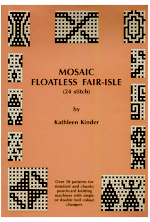 This, by Barbra Walker and intended for hand knitting, offers a huge library of designs for inspiration and conversion
This, by Barbra Walker and intended for hand knitting, offers a huge library of designs for inspiration and conversion 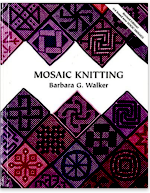 Following specific rules it is also possible to develop DIY repeats from scratch. That said, the repeat used in this blog post happens to have a known value of 12 pixels by 12
Following specific rules it is also possible to develop DIY repeats from scratch. That said, the repeat used in this blog post happens to have a known value of 12 pixels by 12 Magnification in Gimp is achieved by selecting or typing in new percentages at the bottom of the window.
Magnification in Gimp is achieved by selecting or typing in new percentages at the bottom of the window.
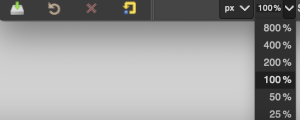 Entering and exiting the full screen may be controlled via the view menu
Entering and exiting the full screen may be controlled via the view menu  To exit, it right-click at the very top of the window to expose menu options and select deselect full screen.
To exit, it right-click at the very top of the window to expose menu options and select deselect full screen.  In Arah, if you press any number from 0-9 on the keyboard, you will change the zoom directly to that level (1 means 100%, 6 means 600%, 0 means 1000%). The plus + and minus keys- as well as the magnifying lens icons, will zoom in and out
In Arah, if you press any number from 0-9 on the keyboard, you will change the zoom directly to that level (1 means 100%, 6 means 600%, 0 means 1000%). The plus + and minus keys- as well as the magnifying lens icons, will zoom in and out  To use the entire space available in the window, choose Fit to Window from the view menu or select Ctrl+zero.
To use the entire space available in the window, choose Fit to Window from the view menu or select Ctrl+zero.
If working in more than one window this option makes repeats the most visible, scaling back can be done by counting the number of selections, helping to match the new picture magnification to the first.
Press the escape key on the keyboard to return to the original 100% view.
To work using the full screen, select the option from the view menu. To exit, right-click at the very top of the window to expose menu options, and select exit full screen  Separating the design: ultimately the planned final graphic repeat would be a BW png used for electronic download, programmed as a fair isle one, but knit using tuck or slip settings, it may be drawn initially using only in those 2 colors. Black may need to be added to the palette selections.
Separating the design: ultimately the planned final graphic repeat would be a BW png used for electronic download, programmed as a fair isle one, but knit using tuck or slip settings, it may be drawn initially using only in those 2 colors. Black may need to be added to the palette selections.
One may always draw on a large canvas and then crop as needed, but as a starting point, it may be easier to simply match canvas size to the published repeat being used.
It is handy to have an extra column to help track image processing during the separation, the repeat above is identified as being composed of 12X12 pixels, one could begin with a 13X12 canvas.
A second way to provide the 13th column is to work using 2 windows, matching magnification, and the second with a different, larger pixel measurement than the first. Copy the contents of the original work area and paste them into the larger canvas in the other window. Crop to new size if necessary.
To illustrate the two-window process, here the original BW repeat has already been drawn and elongated X2
A. Use the rectangle-select tool to capture the whole image in the first window, bounding lines in the colors of the palette in use will outline the selected area
B. Use the edit menu or command C to copy the selection, edit paste, or command V in the new window to place it.
When pasting on a different size ground, the bounding lines will also appear in the new image, the contents remain moveable,
C. Place the selection where desired on the new canvas, when satisfied use the X, merge down tool to flatten it.
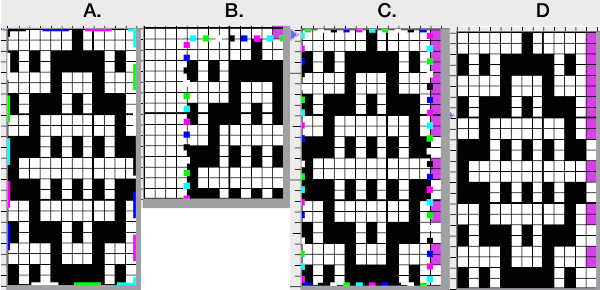 The quicker method begins with a canvas one pixel wider than the repeat, 13X12.
The quicker method begins with a canvas one pixel wider than the repeat, 13X12.
Adjust magnification, for comfortable viewing in the editing process.
View: show grid 2
Colors: set the number of colors to 6, and adjust the #1 color to black, white is in position 0 in the palette by default
Activate the pencil tool, and draw a vertical line on the far right in an easy-to-see color choice other than white or black
Using black, fill in pixels for your first draft of the pattern repeat
Image multiply YX2, resulting in 13X24
Using the pencil tool fill in the first 2 design rows followed by every other pair with white.  Magnify image A to a comfortable work viewing size.
Magnify image A to a comfortable work viewing size.
B and C: using the rectangle select tool, with the left mouse button, place the pointer on the purple pixel, drag the mouse across each pair of marked rows,  release the mouse, and use Command I to color invert, and merge down
release the mouse, and use Command I to color invert, and merge down to eliminate the bounding box.
to eliminate the bounding box.
The purple pixels will change color as well, making it easier to track what rows have been altered already.
D: crop the image, removing the row with colored cells for the final repeat
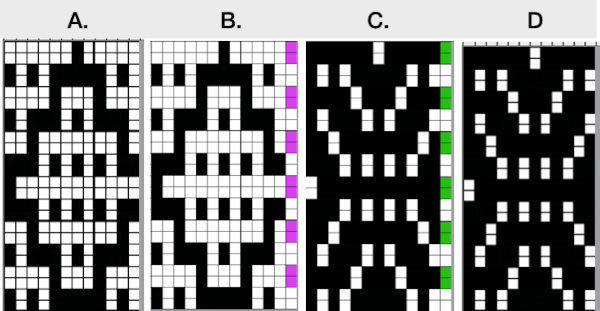 If for some reason you are processing an image that is color reversed, the steps are identical, but tuck or slip stitch fabrics, black pixels or punched holes knit, white pixels or unpunched squares tuck or slip. For this reason, the cropped final result would need to be color inverted prior to knitting or punching holes.
If for some reason you are processing an image that is color reversed, the steps are identical, but tuck or slip stitch fabrics, black pixels or punched holes knit, white pixels or unpunched squares tuck or slip. For this reason, the cropped final result would need to be color inverted prior to knitting or punching holes. 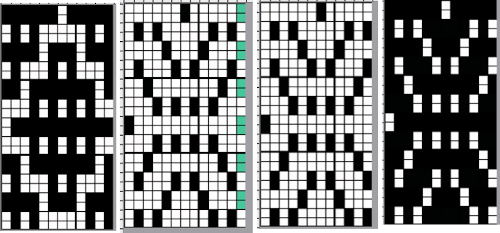 This separation for 2-color DBJ results in its potential use in many fabrics other than DBJ and may be performed by some programs used to download multiple color patterns to the machines prior to knitting the fabric. One such fabric is drop-stitch lace.
This separation for 2-color DBJ results in its potential use in many fabrics other than DBJ and may be performed by some programs used to download multiple color patterns to the machines prior to knitting the fabric. One such fabric is drop-stitch lace.
Punchcard machine users would need to separate the colors manually, or if Dak is available, the separation may be done using the program and a corresponding template may be printed as a guide to punching holes.
This method is the automatic default one for any 2-color DBJ knit on the Passap.
Each color in each design row will be knit with each pair of consecutive color passes. Completing one design row containing 3 colors will require 6 carriage passes, 4 colors 8, and so on.
The built-in color separation in electronic machines wherein each of only 2 colors in each design row knits only once does not apply when using more than two colors, though it is possible using Dak or by downloading a special card reader technique to program separately from the design when using the Passap E6000 in addition to the pattern repeat.
This separation of a 2 color pattern results in an elongated version of the design regardless of any dbj backing used.
Begin with a 2 color image,  an extra column of pixels is added here as well:
an extra column of pixels is added here as well:
A: multiply YX4 to 13X48
B: mark alternating pairs of rows in the extra column with a contrasting color
C: following the color cues on the far right column, on rows with no added color use the pencil tool to replace black pixels with white, leaving only the orange cells
D: on rows marked with the third color replace the orange pixels with white, leaving only the black pixels
E: crop the image eliminating the extra column
adjust the remaining orange color to black
index the result to B/W, and the image is ready to save and use  The difference between single repeats for each type of fabric, no further elongation is required. A: mosaic, B: DBJ
The difference between single repeats for each type of fabric, no further elongation is required. A: mosaic, B: DBJ Using layers in Gimp opens up the possibility of several color separations for fabrics using only 2 colors.
Using layers in Gimp opens up the possibility of several color separations for fabrics using only 2 colors.
Both img2track and Ayab are capable of opening 2 color images.
In img2track this is what would appear, after the download the KRC function needs to be activated in the knitting machine.  Ayab: the repeat should be programmed in width equal to the number of needles planned to be in use. The color change happens as the file is loaded into the program, the ribber classic option is used
Ayab: the repeat should be programmed in width equal to the number of needles planned to be in use. The color change happens as the file is loaded into the program, the ribber classic option is used  to render results that would match the KRC knitting machine selection after an img2track download. Here the repeat is also tiled in height.
to render results that would match the KRC knitting machine selection after an img2track download. Here the repeat is also tiled in height.  My personal preference is to work with images designed in black and white. With the 910 presently stored, my blog swatches are knit on a 930 using img2track.
My personal preference is to work with images designed in black and white. With the 910 presently stored, my blog swatches are knit on a 930 using img2track.
A note for Mac users like myself using desktops with the M1 chip and Mac OS Monterey. Img2 track requires an FTDI driver for its download cable, on June 6 finally released a beta version of a more recent driver, I do not plan to install it at this moment, function in the upcoming Ventura OS would be unknown. ![]() Ayab does not launch automatically. These are the steps necessary to run the program, following suggestions by Adrienne Hunter via the Ayab FB group:
Ayab does not launch automatically. These are the steps necessary to run the program, following suggestions by Adrienne Hunter via the Ayab FB group:
open a Terminal window (Applications/Utilities/Terminal) and type these two lines:
cd /Applications/AYAB.app
./Contents/MacOS/AYAB
The app may also be found and then opened via using Spotlight search if you prefer  Once the program is quit unless you choose to keep the terminal icon
Once the program is quit unless you choose to keep the terminal icon
 in your dock, it will disappear and the above process will need to be repeated. Once the text has been entered, and Ayab has been launched, a message similar to this will appear, showing your last log in.
in your dock, it will disappear and the above process will need to be repeated. Once the text has been entered, and Ayab has been launched, a message similar to this will appear, showing your last log in.![]() To launch Ayab again, simply use the up arrow key and hit return to repeat the command
To launch Ayab again, simply use the up arrow key and hit return to repeat the command  Creating an AYAB desktop shortcut for Mac that will work without opening the terminal each time
Creating an AYAB desktop shortcut for Mac that will work without opening the terminal each time
Using Finder, open Applications and find AYAB. Right-click on AYAB and select “Show Package Contents”.
 Locate “AYAB” under MacOS.
Locate “AYAB” under MacOS.  While holding down the command and option buttons, click and drag that icon to the desktop. This will create an ayab shortcut that does the terminal stuff for you
While holding down the command and option buttons, click and drag that icon to the desktop. This will create an ayab shortcut that does the terminal stuff for you  you can change the icon by copying and pasting the icon image in “get info” but it works fine without it. These icons will appear in your dock after double clicking on the icon
you can change the icon by copying and pasting the icon image in “get info” but it works fine without it. These icons will appear in your dock after double clicking on the icon 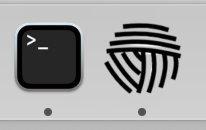 The ayab window opens with only the load image option highlighted
The ayab window opens with only the load image option highlighted 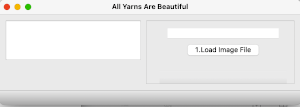 Click on the load image file to open an image, and the remaining features of the program will now be available
Click on the load image file to open an image, and the remaining features of the program will now be available 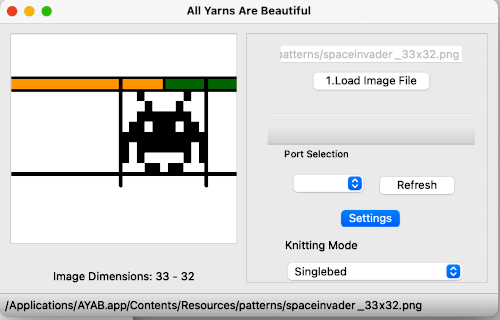 If you quit ayab, the terminal window remains active
If you quit ayab, the terminal window remains active  Quitting terminal called up this window for me only the first time I did so.
Quitting terminal called up this window for me only the first time I did so. 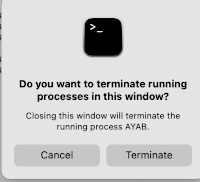
A ladder back dbj quest
The previous discussion on this topic: Ladderback double jacquard: backing variations
This backing technique has traditionally been used when the yarns are simply too thick to be worked in traditional dbj backing methods.
The majority of the needles will be knit on the main bed, so the tension should approximate that used for the same yarn worked in stocking stitch single bed.
The pattern will become a slip stitch one, with colors changed every two rows.
A FB Machine Knitting Group share led to a query on how this block type of ladder back might be duplicated on home knitting machines. 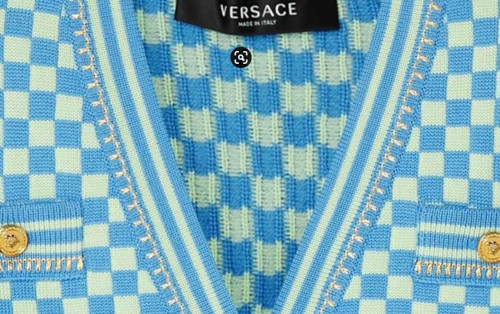
 My interpretation of the knit:
My interpretation of the knit:  the planned block repeat, in turn, needs to be color separated and scaled for use in dbj.
the planned block repeat, in turn, needs to be color separated and scaled for use in dbj.
This chart was developed using Numbers:
A: each color in each row is represented only once
B: the same repeat in black and white
C: the repeat double length so that each color is changed every 2 rows
D: getting the pattern to shift for every other pair of blocks is actually achieved by knitting the last 2 rows and the first two rows of the next repeat using the same color for 4 consecutive rows.
If the repeat is downloaded and programmed to be 24 rows long, the reminder to knit with the same color again is easy, since the pattern will roll back to row 1 with a warning, in this case, not to change color. It is easy enough to alter the height of the repeat to use this particular reminder. 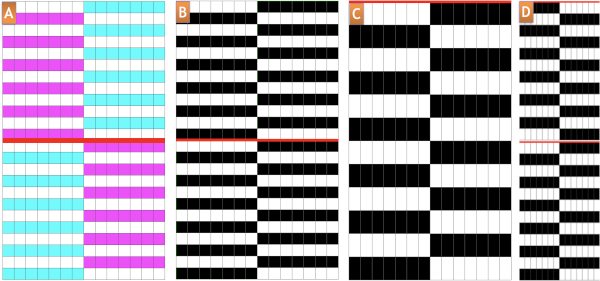 The motif used in the swatches is 14 stitches wide by 24 stitches high
The motif used in the swatches is 14 stitches wide by 24 stitches high ![]() The machine set up: the main bed needles will need to continue to have weight evenly distributed on them, so the ribber comb placement needs to reflect that. The cast-on method can be one you prefer. I began with waste yarn, the ribber comb poked evenly through that, with the added use of ribber weights.
The machine set up: the main bed needles will need to continue to have weight evenly distributed on them, so the ribber comb placement needs to reflect that. The cast-on method can be one you prefer. I began with waste yarn, the ribber comb poked evenly through that, with the added use of ribber weights.
The pitch setting is for every needle rib.
End needle selection is used as in fair isle knitting to ensure that end stitches will be knit when either color is knit only on the top bed, resulting in the B feeder yarn being secured on the edge. If the end needle selection fails for any reason on the carriage side, push the needle forward manually.
The needle arrangement with red lines marking the location on the opposite bed.![]()
 COR: the first pass is made toward the color changer
COR: the first pass is made toward the color changer
COL: every other group of 7 needles is preselected, set both carriages to slip in both directions, change color if preferred, and bring up ribber needles in between those selected on the top bed to D position as shown here, on both the pass to the right and the return pass to the left.  As the carriages make the pair of passes, floats will be created across the alternate group of 7 needles. Those floats will become secured as the next group of needles is selected and ribber stitches are brought up to form a line of knit stitches in the contrasting color in front of them.
As the carriages make the pair of passes, floats will be created across the alternate group of 7 needles. Those floats will become secured as the next group of needles is selected and ribber stitches are brought up to form a line of knit stitches in the contrasting color in front of them. 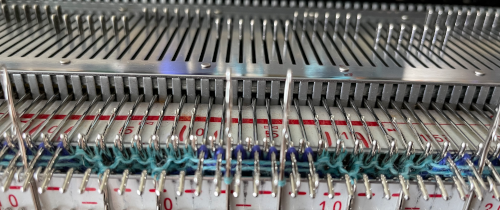 The yarn used here is 2/20 wool, really too thin for this type of backing, but I wanted to test the repeat and the concept.
The yarn used here is 2/20 wool, really too thin for this type of backing, but I wanted to test the repeat and the concept.  Using a 2/8 wool the result was optically the best, but I could not get any further than this without stitches jumping off needles in several places, regardless of tension adjustments
Using a 2/8 wool the result was optically the best, but I could not get any further than this without stitches jumping off needles in several places, regardless of tension adjustments  Using yarns in weight in between the 2, knitting was smooth, the tension on the top bed was set at tight as possible, this is the appearance of the knit on the machine
Using yarns in weight in between the 2, knitting was smooth, the tension on the top bed was set at tight as possible, this is the appearance of the knit on the machine 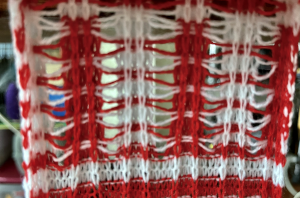 Off the machine, the bleed-through from the floats created on the top bed on the knit side begins to remind one of knit weaving as does the purl side. Not the intended effect and fabric, but perhaps worth pursuing intentionally.
Off the machine, the bleed-through from the floats created on the top bed on the knit side begins to remind one of knit weaving as does the purl side. Not the intended effect and fabric, but perhaps worth pursuing intentionally. 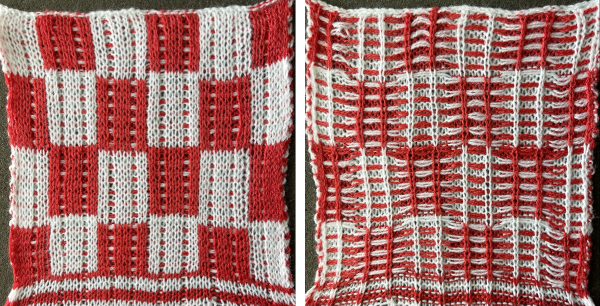
Geometric shapes in drop stitch lace 4, stitch release, added racking
Though written in 2017, the post on revisiting drop/release stitch lace 1 has had new swatches and updated design ideas added. It includes information on how to use punchcards intended for other fabrics as possible design ideas and a cumulative list of previous posts on drop stitch lace.
The Brother publications have offered this idea for end release drop stitch in one of their volumes of punchcard patterns.  Many published designs recommend beginning the knitting with the racking handle in the center position, 5 of 1-10 positions in Brother, and 0 of 6, 3-3 in Passap. Often the starting position is relative and when a lot of racking is involved, they may be varied, though not the sequences in terms of the number of movements, to different starting points if that seems to offer an easier way to track position numbers. It is one of the many things that once the method is sorted may be adjusted to personal preference. Some of my swatches below were started with the racking position on 10, some with it on 5.
Many published designs recommend beginning the knitting with the racking handle in the center position, 5 of 1-10 positions in Brother, and 0 of 6, 3-3 in Passap. Often the starting position is relative and when a lot of racking is involved, they may be varied, though not the sequences in terms of the number of movements, to different starting points if that seems to offer an easier way to track position numbers. It is one of the many things that once the method is sorted may be adjusted to personal preference. Some of my swatches below were started with the racking position on 10, some with it on 5.
Many knitters in forums appear to have success with end release drop stitch. My experience has been that episodic release of the stitches even as often as after 2 rows knit yields far more predictable results. It is how I worked my shawls produced in the technique, including these two, knit in days when I did not always photograph all my pieces  Giving end release another go, this was my initial needle set up. With the majority of the needles in work on the main bed, the larger stitches in the final fabric will dominate. The stitches after the cast on have been transferred down to the ribber.
Giving end release another go, this was my initial needle set up. With the majority of the needles in work on the main bed, the larger stitches in the final fabric will dominate. The stitches after the cast on have been transferred down to the ribber. 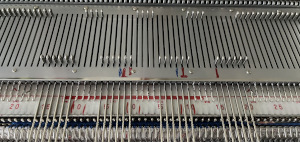 The work on the machine, with stitches on the main bed released at the end of the swatch.
The work on the machine, with stitches on the main bed released at the end of the swatch.  There is a long stitch DBJ single color pattern happening which may prove to be an interesting fabric if no stitches are dropped, to preserve it, all stitches would be transferred to the top bed, and bound off.
There is a long stitch DBJ single color pattern happening which may prove to be an interesting fabric if no stitches are dropped, to preserve it, all stitches would be transferred to the top bed, and bound off.
Here the racking took place in single positions after every knit row. Dropping stitches on completion of the swatch, particularly along the edges was so fiddly and such a nuisance I simply gave up in spots, some indicated by red dots.  This watch had stitches released at the end of each shape, racking in the top portion occurred after every 2 rows knit
This watch had stitches released at the end of each shape, racking in the top portion occurred after every 2 rows knit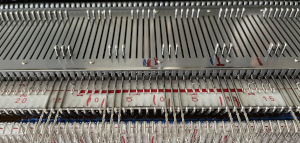
 Here the same design was knit using different yarns. The first is knit using the same blue wool, the second a tightly spun rayon.
Here the same design was knit using different yarns. The first is knit using the same blue wool, the second a tightly spun rayon. 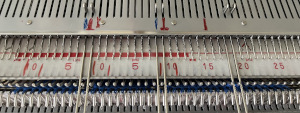
 So many fabrics can be automated, sometimes the fabric is a vague look-alike cousin of the original, close enough to be a reasonable compromise. Slip stitch patterning across the top bed can offer a quick solution to bypassing a lot of hand manipulation. Assuming that was possible for this fabric, my starting repeat, 10X30 pixels:
So many fabrics can be automated, sometimes the fabric is a vague look-alike cousin of the original, close enough to be a reasonable compromise. Slip stitch patterning across the top bed can offer a quick solution to bypassing a lot of hand manipulation. Assuming that was possible for this fabric, my starting repeat, 10X30 pixels: ![]() and the plan would be to knit it in a 40 stitch swatch, placed in a way so that the “mock racking” would move equally from side to side. Working on a larger than needed canvas, the design can be placed on a magnified work area with a visible grid, at the chosen starting point. If the background is left as white in BW images, moving repeat spacing may erase black pixels as copy and paste in place are used. The solution is to make the background transparent using the Layer menu, as explained in other posts on using Gimp.
and the plan would be to knit it in a 40 stitch swatch, placed in a way so that the “mock racking” would move equally from side to side. Working on a larger than needed canvas, the design can be placed on a magnified work area with a visible grid, at the chosen starting point. If the background is left as white in BW images, moving repeat spacing may erase black pixels as copy and paste in place are used. The solution is to make the background transparent using the Layer menu, as explained in other posts on using Gimp. 
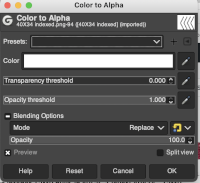
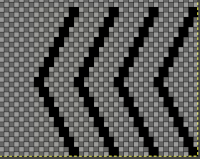 To save the repeat as a BW bmp or png, remove the alpha channel
To save the repeat as a BW bmp or png, remove the alpha channel 
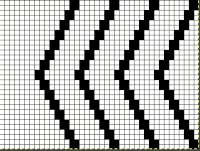 The final repeat is 40 stitches wide, 34 high,
The final repeat is 40 stitches wide, 34 high, 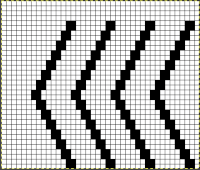
![]() with blank rows added to its top to serve as a place to drop stitches and have knitting happening on the ribber only.
with blank rows added to its top to serve as a place to drop stitches and have knitting happening on the ribber only.
Depending on the download program or the knitting machine model number, repeats are automatically mirrored, so if direction matters, mirroring of the repeat may need to be performed once more.
Why the repeat will not work for drop stitch: if the KC is set to slip in both directions, the function will happen on all needles in work on the top bed. On any given row, only black pixels (or punched holes) will knit. The slipped/ skipped stitches keep elongating until a black pixel replaces the white one in that needle location. The degree of elongation is illustrated in the chart in color for part of the repeat, the yellow marks the widest gap between knit stitches. If knit as is the repeat will soon cause serious knitting problems and carriage jams.  Though designing for one type of fabric may fail, this repeat or similar could be used successfully double bed in other ways, using hand transfers on the top bed or down to the ribber. In this case, I chose to transfer down to the ribber, which avoids concerns about restoring correct needle selection, and the repeat was not mirrored for use on my 930, so the resulting knit appears as drawn on the purl side, but is mirrored on the knit side.
Though designing for one type of fabric may fail, this repeat or similar could be used successfully double bed in other ways, using hand transfers on the top bed or down to the ribber. In this case, I chose to transfer down to the ribber, which avoids concerns about restoring correct needle selection, and the repeat was not mirrored for use on my 930, so the resulting knit appears as drawn on the purl side, but is mirrored on the knit side.
The fabric is far removed from the drop stitch idea, but as for drop stitch lace, stitches after the cast on are transferred to the bottom bed.
Newly selected empty needles will create eyelets with the next 2 carriage passes, and texture will appear on both sides at the transfer down locations.
The shapes created do not travel on the knitting bed any longer.
End needle selection needs to be canceled at any time that slip stitch patterning is used and does not occur on every needle on the top bed.
If the pattern is to be interrupted by all knit rows here seen as rows with no preselection in the programmed repeat, then any needles with stitches on them need to be transferred down to the bottom bed before continuing to knit.
As preselection begins again, those needles should be filled by picking up from the stitches below them on the ribber, and then the process may be repeated.
